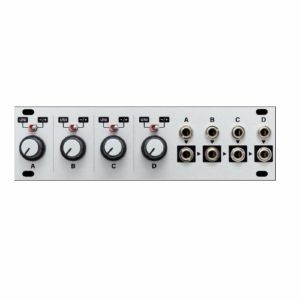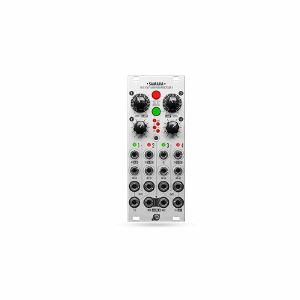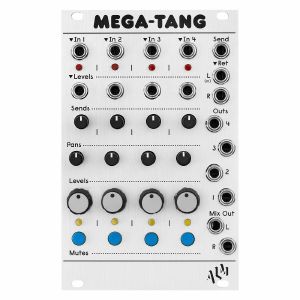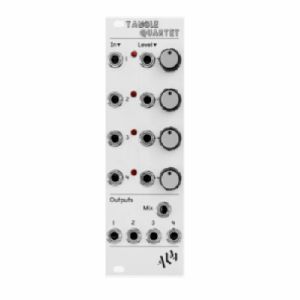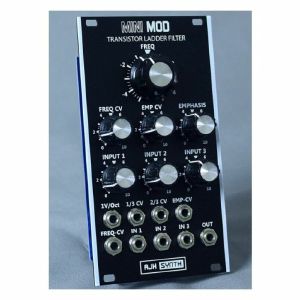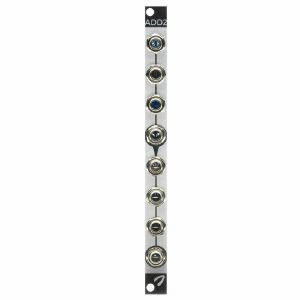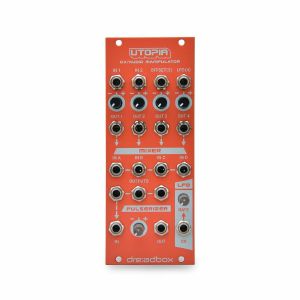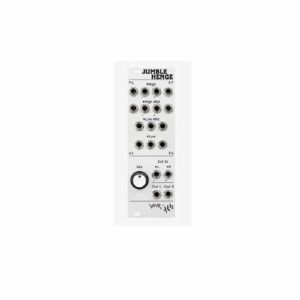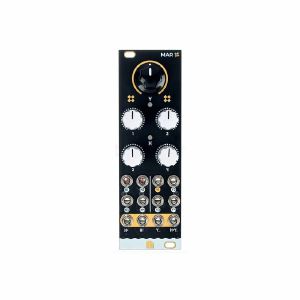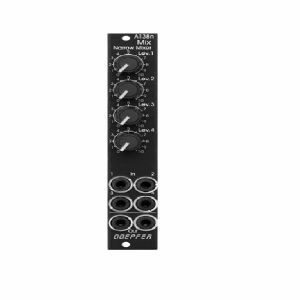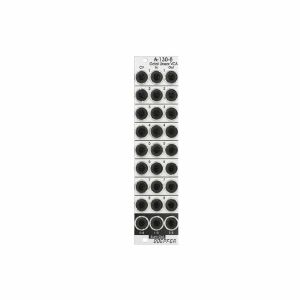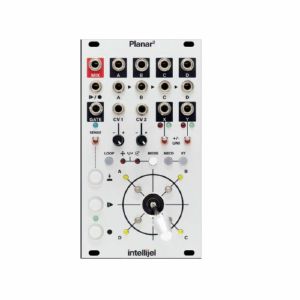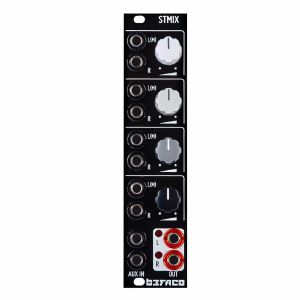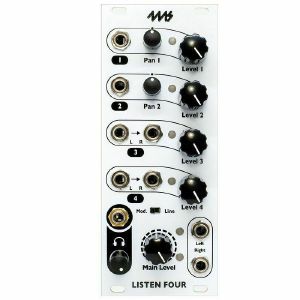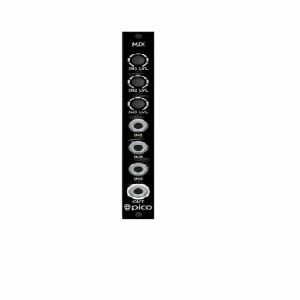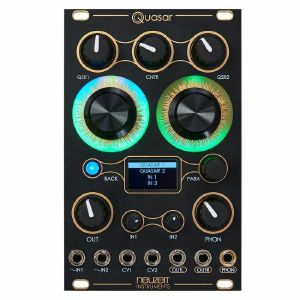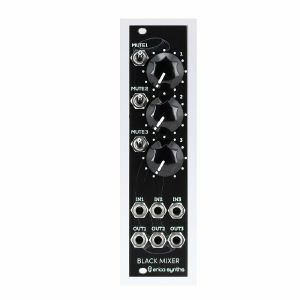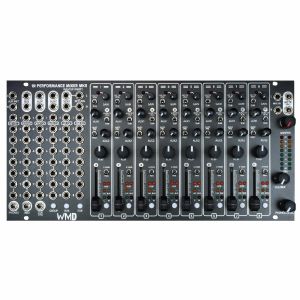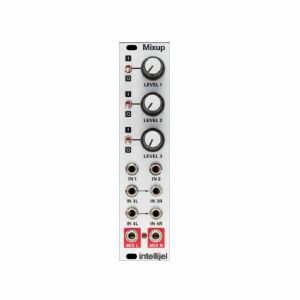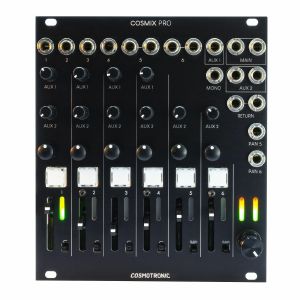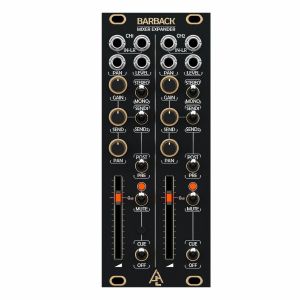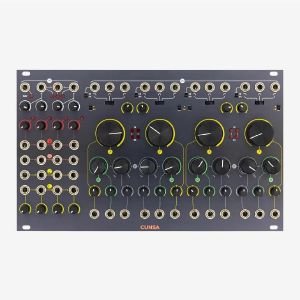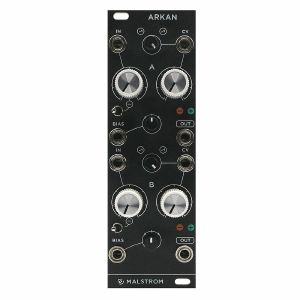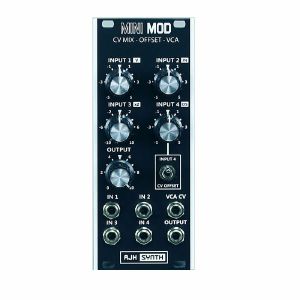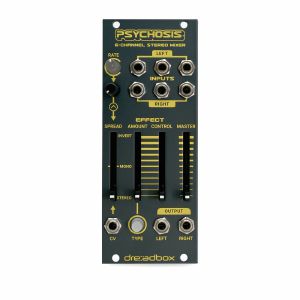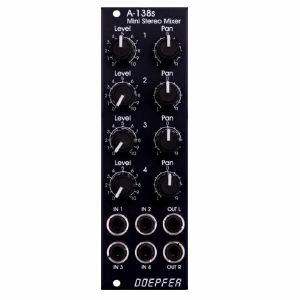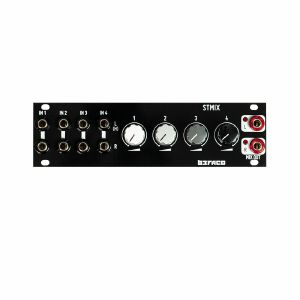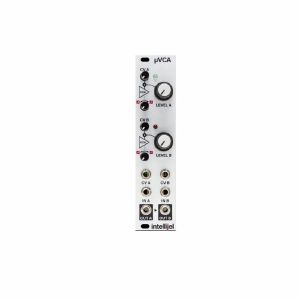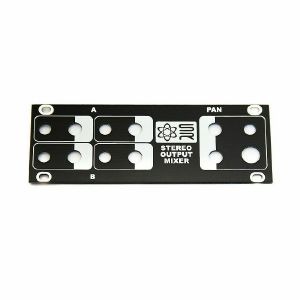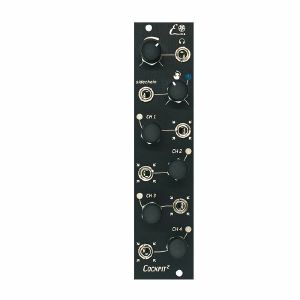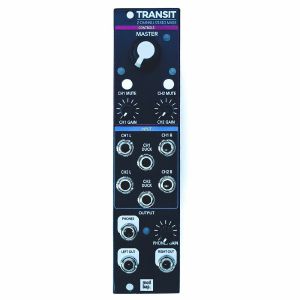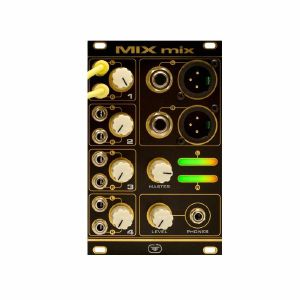Filter
Equipment
Format
Featured
Price
Tags
76
Mixer module
19
VCA module
11
Attenuator module
9
Utility module
4
Effects module
4
Multiple module
3
Distortion module
3
Filter module
3
Waveshaper module
2
Attenuverter module
2
Envelope generator module
2
Ring modulator module
1
CV modulation module
1
Compressor module
1
Controller module
1
Equaliser module
1
Expander module
1
Function generator module
1
LFO module
1
Oscillator module
1
Preamp module
1
Sample & hold module
1
Switch module
Studio Equipment charts
Bestselling Studio Equipment vinylIntellijel Quadratt 1U Quad Attenuator Attenuverter Mixer & DC Voltage Source Module (attenuator/mixer/utility/CV modulation synth module)
Cat: 602205 Rel: 04 Apr 16
Quad attenuator, attenuverter, mixer and DC voltage source - 28HP wide
Notes: The shorter and wider brother to the popular Triatt module!
The four handy knobs can act as active attenuators (unipolar) or attenuverters (bipolar) depending on the setting of the two-position switches above each one.
Each input is normalled to a precision +5V DC voltage source. With nothing plugged into the jacks, each knob controls a voltage range of 0 to +5 v or -5 to +5 v depending on the position of the mode switch.
- 2 modes for each channel
- 5v normalled to each input
- With external signals it acts as active/buffered attenuator/attenuverter/mixer
- Each output normalled to mix into the adjacent channel on the right making it possible to do sub mixes in groups of 2, 3 or all four channels.
… Read moreThe four handy knobs can act as active attenuators (unipolar) or attenuverters (bipolar) depending on the setting of the two-position switches above each one.
Each input is normalled to a precision +5V DC voltage source. With nothing plugged into the jacks, each knob controls a voltage range of 0 to +5 v or -5 to +5 v depending on the position of the mode switch.
- 2 modes for each channel
- 5v normalled to each input
- With external signals it acts as active/buffered attenuator/attenuverter/mixer
- Each output normalled to mix into the adjacent channel on the right making it possible to do sub mixes in groups of 2, 3 or all four channels.
2 in stock $79.58
Click for better price!
or call +44 20 7424 1960
quote 602205
quote 602205
Xaoc Devices Samara II 1962 Utility Waveform Processor Module (attenuator/mixer/multiple/polarizer/sample&hold/switch/utility synth module)
Cat: 633371 Rel: 14 Feb 17
A flexible mixer and a multifunction utility module that may be used for processing audio signals, control voltages and modulation waveforms.
Notes: Samara is a "Swiss Army Knife" type of module, intended to serve the most common voltage and audio signal processing purposes such as attenuation, offsetting, mixing, inverting, and even basic waveshaping. Samara features four channels, each with two inputs and an attenuator, additional switchable offset generators, four voltage level and polarity indicators, two adders with switchable scale, and a precision four-channel processor that selects minimum and maximum voltage.
… Read more 2 in stock $181.28
ALM Mega-Tang 4-Channel Linear VCA & Stereo Mixer Module (mixer/VCA synth module)
Cat: 914301 Rel: 05 Dec 22
A 4-channel linear VCA and stereo mixer providing per input control over level, effect send, pan and muting.
Notes: The 'MEGA-TANG' is a 4-channel linear VCA and stereo mixer providing per input control over level, effect send, pan and muting. Designed for live use in mind with a simple & compact layout, the 'MEGA-TANG' builds on the clean and transparent sounding Tangle Quartet VCA by adding a stereo mix output, effect sends (mono send with a stereo return) which pair great with the MFX, manual panning, soft mute buttons with LED indicators and an expansion port for future expandability.
Individual VCA outputs are available which remove the channel from the main mix (useful for cueing and monitoring). All signals are Euro level and bar the effects return, DC coupled for CV use as well as audio.
Technical Specifications
Power: +12V 125ma -12V 125ma
Size: 16HP
Depth: 32mm
Attenuation: approx -70db
… Read moreIndividual VCA outputs are available which remove the channel from the main mix (useful for cueing and monitoring). All signals are Euro level and bar the effects return, DC coupled for CV use as well as audio.
Technical Specifications
Power: +12V 125ma -12V 125ma
Size: 16HP
Depth: 32mm
Attenuation: approx -70db
2 in stock $263.08
Intellijel Quad VCA Voltage Controlled Amplifier & Cascaded Mixer Module (VCA/mixer synth module)
Cat: 643379 Rel: 13 Sep 17
Quad voltage controlled amplifier & cascaded mixer - 12HP wide
Notes: The Quad VCA is a compact and feature packed module that is sure to find its way it almost all of your patches. In addition to being used for standard VCA duties it can also be used as a mixer and signal booster.
Features:
- Manual LEVEL control per VCA which is convenient when using the module as a mixer or for biasing when CV modulating the VCA with a bipolar LFO.
- Dedicated CV attenuators with dual colour LEDs for monitoring bipolar CV signals.
- Continuously adjustable response from linear to exponential per VCA.
- Each CV input is normalled to the adjacent one for cascaded control.
- Each output is normalled to the mix input of the adjacent one which allows you to use adjacent sets as submixes or the fourth output can be used as a master mix output when none of the other outputs are patched.
- Each VCA has a boost switch that increases the output level by approximately +6dB (double).
… Read moreFeatures:
- Manual LEVEL control per VCA which is convenient when using the module as a mixer or for biasing when CV modulating the VCA with a bipolar LFO.
- Dedicated CV attenuators with dual colour LEDs for monitoring bipolar CV signals.
- Continuously adjustable response from linear to exponential per VCA.
- Each CV input is normalled to the adjacent one for cascaded control.
- Each output is normalled to the mix input of the adjacent one which allows you to use adjacent sets as submixes or the fourth output can be used as a master mix output when none of the other outputs are patched.
- Each VCA has a boost switch that increases the output level by approximately +6dB (double).
3 in stock $184.60
Doepfer A-138n Narrow Mixer Module (silver, slim line series) (mixer synth module)
Cat: 731947 Rel: 10 Jun 19
4-channel mixer module - 4HP
Notes: Module A-138n is a simple four channel mixer, which can be used with either control voltages or audio signals. Each of the four inputs has an attenuator available. The output is twice available (two sockets, hard-wired like a multiple).
The module is the slim version of module A-138a and offers nearly the same features. But the distances between the controls are smaller and rubberized small-sized knobs are used. In return the front panel has 4 HP only which is half the width of the A-138a. The module is primarily planned for applications where only limited space is available. The only functional difference compared to the A-138a is the missing attenuator for the (dual) output.
Width: 4HP / 20.0 mm
Depth: 30 mm (measured from the rear side of the front panel)
Current: +10mA (+12V) / -10mA (-12V)
… Read moreThe module is the slim version of module A-138a and offers nearly the same features. But the distances between the controls are smaller and rubberized small-sized knobs are used. In return the front panel has 4 HP only which is half the width of the A-138a. The module is primarily planned for applications where only limited space is available. The only functional difference compared to the A-138a is the missing attenuator for the (dual) output.
Width: 4HP / 20.0 mm
Depth: 30 mm (measured from the rear side of the front panel)
Current: +10mA (+12V) / -10mA (-12V)
4 in stock $57.56
ALM Tangle Quartet Quad Linear VCA & Mixer Module (quad/VCA/mixer/attenuator synth module)
Cat: 584259 Rel: 15 Apr 16
High quality quad linear voltage controlled amplifier (VCA) synthesiser module - 8HP wide
Notes: 'Tangle Quartet' is a high quality quad linear voltage controlled amplifier (VCA) providing individual level control of 4 signal inputs with both individual outputs and a combined 'mix' output (for non patched outputs) . Control signal inputs and associated attenuation controls allow for voltage control of signal levels. Control inputs are normalised to 5v thus providing manual mix control in the absence of control signals.
Technical Specifications:
Supply: +/-12V (Reverse voltage protection)
Current Draw: ~80ma
Size: 8 HP
Depth: 32mm (including power header)
… Read moreTechnical Specifications:
Supply: +/-12V (Reverse voltage protection)
Current Draw: ~80ma
Size: 8 HP
Depth: 32mm (including power header)
1 in stock $185.70
Click for better price!
or call +44 20 7424 1960
quote 584259
quote 584259
Serge 2+2 Mixer/Dual VCA Module (mixer/VCA synth module)
Cat: 1075446 Rel: 07 Mar 25
A powerful utility module with two DC coupled 2-channel mixers with a sum out, and an audiophile and distortion friendly VCA
Notes: A powerful utility module:
The 2+2 Mixer (left side) is a combo of two DC coupled 2-channel mixers with a sum out. For audio or CV purposes.
The Dual VCA is the audiophile and distortion friedly VCA taken from the Stereo Mixer. It has a special exponential response that imitates the behavior of the early Serge VCAs and allows massive amplification and overdrive. Beware - the resulting signal can get very high amplitudes (up to 16Vpp) and allows squaring of a sine or triangle wave.
Serge 2+2 Mixer / Dual VCA for eurorack:
Designed for audio performance
Eurorack format (3U), 18 hp
Power consumption: 55mA @ +12V, 50mA @ -12V
(NEW) Skiff-friendly: < 25mm (1")
… Read moreThe 2+2 Mixer (left side) is a combo of two DC coupled 2-channel mixers with a sum out. For audio or CV purposes.
The Dual VCA is the audiophile and distortion friedly VCA taken from the Stereo Mixer. It has a special exponential response that imitates the behavior of the early Serge VCAs and allows massive amplification and overdrive. Beware - the resulting signal can get very high amplitudes (up to 16Vpp) and allows squaring of a sine or triangle wave.
Serge 2+2 Mixer / Dual VCA for eurorack:
Designed for audio performance
Eurorack format (3U), 18 hp
Power consumption: 55mA @ +12V, 50mA @ -12V
(NEW) Skiff-friendly: < 25mm (1")
3 in stock $313.93
Doepfer A-135-2 Quad VCA & Voltage Controller Mixer Module (silver) (VCA/mixer synth module)
Cat: 714704 Rel: 22 Jan 19
Compact voltage-controlled four-channel audio mixer - 8HP
Notes: A-135-2 is a miniature version of the A-135-1. Behind a front panel with 8 HP only four linear VCAs (voltage controlled amplifiers) and a voltage controlled mixer based on the VCAs are available.
Controls, In/Outputs and Functions of each VCA:
- Level (manual control of the VCA amplification), small rubberized knob (L1...L4)
- Control voltage input with associated attenuator (CV1...CV4), for the full VCA control range about 0...+5V control voltage are required (attenuator fully clockwise), for higher control voltages the attenuator is used, the attenuators are without knobs, just plastic shafts with white marker
- Signal Input
- Signal Output
- All inputs and outputs are DC coupled. Consequently the VCAs can be used to process both audio and control voltages (e.g. to control the level of LFOs or envelopes)
- The signal input is not equipped with an attenuator. But the VCAs can process all signals up to 15Vpp / -7.5...+7.5V without clipping. In case of higher levels an external attenuator is required (e.g. A-183-1).
- The available amplification range is 0...1, the maximal amplification is 1 (i.e. it "clips" and remains at 1 even if the control voltage goes beyond the value that corresponds to amplification 1)
Functions of the voltage controlled mixers:
- Two outputs ("Selected" and "All")
- Selected output: the ouput if a VCA is removed from this sum signal when a plug is inserted into the corresponding VCA output.
- All output: sum of all VCA outputs, regardless of inserted plugs into the VCA outputs
- The maximal amplification is about 0.6 to avoid clipping at the mixer outputs (otherwise the outputs may distort with 15Vpp signals at each signal input and full amplifications)
Special functions of the voltage controlled mixers (selectable by internal jumpers):
- Dual Stereo VCA: In this case the control unit of VCA1 (L1 + CV1) affects also VCA3 and the control unit of VCA2 (L2 + CV2) affects also VCA4, the control units of VCA2 and VCA4 are out of operation
- Quad VCA: In this case the control unit of VCA1 (L1 + CV1) affects all four VCAs. The control units of VCA2, VCA3 and VCA4 are out of operation. In this mode the module has the same function as module A-132-2. That's why module A-132-2 will be discontinued.
- Normalling of the signal inputs: by means of internal jumpers signal input 1 can be normalled to signal input 2, signal input 2 to signal input 3 and signal input 3 to signal input In 4. That way the same input signal can be distributed to four different channels by means of control voltages (e.g. quadrophonic distribution of audio signals). Suitable control voltage sources are e.g. A-144 (Morphing Controller) or A-143-9 (Quadrature LFO).
… Read moreControls, In/Outputs and Functions of each VCA:
- Level (manual control of the VCA amplification), small rubberized knob (L1...L4)
- Control voltage input with associated attenuator (CV1...CV4), for the full VCA control range about 0...+5V control voltage are required (attenuator fully clockwise), for higher control voltages the attenuator is used, the attenuators are without knobs, just plastic shafts with white marker
- Signal Input
- Signal Output
- All inputs and outputs are DC coupled. Consequently the VCAs can be used to process both audio and control voltages (e.g. to control the level of LFOs or envelopes)
- The signal input is not equipped with an attenuator. But the VCAs can process all signals up to 15Vpp / -7.5...+7.5V without clipping. In case of higher levels an external attenuator is required (e.g. A-183-1).
- The available amplification range is 0...1, the maximal amplification is 1 (i.e. it "clips" and remains at 1 even if the control voltage goes beyond the value that corresponds to amplification 1)
Functions of the voltage controlled mixers:
- Two outputs ("Selected" and "All")
- Selected output: the ouput if a VCA is removed from this sum signal when a plug is inserted into the corresponding VCA output.
- All output: sum of all VCA outputs, regardless of inserted plugs into the VCA outputs
- The maximal amplification is about 0.6 to avoid clipping at the mixer outputs (otherwise the outputs may distort with 15Vpp signals at each signal input and full amplifications)
Special functions of the voltage controlled mixers (selectable by internal jumpers):
- Dual Stereo VCA: In this case the control unit of VCA1 (L1 + CV1) affects also VCA3 and the control unit of VCA2 (L2 + CV2) affects also VCA4, the control units of VCA2 and VCA4 are out of operation
- Quad VCA: In this case the control unit of VCA1 (L1 + CV1) affects all four VCAs. The control units of VCA2, VCA3 and VCA4 are out of operation. In this mode the module has the same function as module A-132-2. That's why module A-132-2 will be discontinued.
- Normalling of the signal inputs: by means of internal jumpers signal input 1 can be normalled to signal input 2, signal input 2 to signal input 3 and signal input 3 to signal input In 4. That way the same input signal can be distributed to four different channels by means of control voltages (e.g. quadrophonic distribution of audio signals). Suitable control voltage sources are e.g. A-144 (Morphing Controller) or A-143-9 (Quadrature LFO).
1 in stock $131.42
AJH Synth MiniMod Transistor Ladder Filter Minimoog VCF Module (black) (sound processor synth module)
Cat: 625060 Rel: 22 Sep 16
Mini Mod VCF Transistor Ladder Filter Module
2 in stock $231.02
Intellijel XFade 1U DJ-Style Stereo Crossfader Module (dual/stereo/mixer synth module)
Cat: 912806 Rel: 05 Dec 22
Stereo crossfader with Innofader moving capacitance technology
Notes: XFADE 1U is a classic DJ-style stereo crossfader, with a few extra tricks up its sleeve. The 'A' and 'B' sides both have L+R inputs. The crossfader blends two stereo input signals together - crossfading one into the other depending on the position of the slider and the selected XFADE Shape. The blended output appears at the MIX L and MIX R output jacks.
In addition, XFADE 1U can be used as a modulation source for controlling other modules, since the crossfader also outputs control voltages from the CV A and CV B jacks. A switch determines whether these voltages are unipolar (crossfading from 0V to 5V; and 5V to 0V), or bipolar (crossfading from -5V to +5V; and +5V to -5V). The two LEDs indicate the polarity and relative levels of the CV A and CV B signals.
XFADE 1U uses a precision Innofader crossfader submodule, with moving capacitance technology for smooth and precise control. This is the same part found on many high-end DJ mixers.
Features:
Smooth and ultra-low friction Innofader Mini-Innofader module with moving capacitance technology
Stereo or Mono operation
DC coupled inputs and outputs
Three crossfade shapes: DJ cut, Constant Power and Linear
Unipolar or Bipolar CV outputs
Width: 26HP
Depth: 38mm
Power: 48mA @ +12V / 41mA @ -12
… Read moreIn addition, XFADE 1U can be used as a modulation source for controlling other modules, since the crossfader also outputs control voltages from the CV A and CV B jacks. A switch determines whether these voltages are unipolar (crossfading from 0V to 5V; and 5V to 0V), or bipolar (crossfading from -5V to +5V; and +5V to -5V). The two LEDs indicate the polarity and relative levels of the CV A and CV B signals.
XFADE 1U uses a precision Innofader crossfader submodule, with moving capacitance technology for smooth and precise control. This is the same part found on many high-end DJ mixers.
Features:
Smooth and ultra-low friction Innofader Mini-Innofader module with moving capacitance technology
Stereo or Mono operation
DC coupled inputs and outputs
Three crossfade shapes: DJ cut, Constant Power and Linear
Unipolar or Bipolar CV outputs
Width: 26HP
Depth: 38mm
Power: 48mA @ +12V / 41mA @ -12
2 in stock $191.23
Erica Synths Black Mixer/Splitter v2 Audio/CV Mixer & Multiple Module (multiple/mixer module)
Cat: 826616 Rel: 17 Jun 21
Input mixer/output signal splitter module - 4HP
Notes: Introducing a four independently buffered input mixer and a buffered output signal splitter, in one module!
Erica Synths Black Mixer/Splitter V2 is an advanced replacement for stackable patchcables.
Everyone who knows a bit more about electronics will point out that stackable patchcables are not a really wise choice for such sensitive things as musical instruments because they mechanically connect electrical signals that at best can cause undesired modulations or even damage the modules.
Erica Black series are high-end modules with unique functionality. Only the highest quality components are used and all inputs and outputs are protected against undesired overvoltage. When designing the Black Series, design and usability were prioritised first. Big knobs are assigned to functions that make difference in sound. Together the Erica Black series are a range of modules that make an entire synthesizer.
Technical specifications:
Input signal level: -10V - +10V
Power consumption: +25mA, -25mA
Module width: 4HP
Module depth: 25mm
… Read moreErica Synths Black Mixer/Splitter V2 is an advanced replacement for stackable patchcables.
Everyone who knows a bit more about electronics will point out that stackable patchcables are not a really wise choice for such sensitive things as musical instruments because they mechanically connect electrical signals that at best can cause undesired modulations or even damage the modules.
Erica Black series are high-end modules with unique functionality. Only the highest quality components are used and all inputs and outputs are protected against undesired overvoltage. When designing the Black Series, design and usability were prioritised first. Big knobs are assigned to functions that make difference in sound. Together the Erica Black series are a range of modules that make an entire synthesizer.
Technical specifications:
Input signal level: -10V - +10V
Power consumption: +25mA, -25mA
Module width: 4HP
Module depth: 25mm
2 in stock $71.84
Befaco Percall VC Quad Decay & 4-Channel Mixer Module (mixer synth module)
Cat: 739916 Rel: 02 Jun 20
VC quad decay & four channel mixer - 12HP
Notes: From trickling hi-hats to thunderous kicks. The Befaco Percall 4-Channel VCA/Delay Envelope Module is designed to take care of all percussive aspects of your Eurorack rig. You'll be able to create a whole host of percussion thanks to the 4 VCAs, volume control and decay options. By using the trigger you'll be free to open the VCA whilst the volume knob helps determine the level of the percussive sound you've sculpted. Take your tones to the next level thanks to the inclusion of an output on the envelope. You can apply this to the pitch of the oscillator to achieve a fat kick drum which offers excellent low frequency energy. The Percall 4-channel module is the ultimate addition to your Eurorack.
… Read more1 in stock $233.24
Joranalogue Add 2 Precision Adder & Averager Module (mixer synth module)
Cat: 757115 Rel: 07 Jan 20
Precision adder/averager in an ultra-narrow 2HP
Notes: To any new modular system owner, the need to easily combine different voltage sources quickly becomes apparent. While a mixer is the obvious solution, these modules are not suitable for adding precise pitch control voltages (CVs) since the channel gains cannot be set exactly to unity.
Add 2 provides a compact solution to this problem, precisely summing the input signals down to 1 or 2 outputs. Alternatively, each section can be configured as an averager using the jumpers on the rear. This way, LFO waveforms or audio sources can be combined while maintaining the average signal level and avoiding clipping. The high-end components provide exceptional performance, making Add 2 suitable for audio, control voltages and gates/triggers.
With the bottom section's first input not in use, the top output is injected into the bottom. This allows 5 signals to be combined into 2 outputs, adding flexibility to your patching.
… Read moreAdd 2 provides a compact solution to this problem, precisely summing the input signals down to 1 or 2 outputs. Alternatively, each section can be configured as an averager using the jumpers on the rear. This way, LFO waveforms or audio sources can be combined while maintaining the average signal level and avoiding clipping. The high-end components provide exceptional performance, making Add 2 suitable for audio, control voltages and gates/triggers.
With the bottom section's first input not in use, the top output is injected into the bottom. This allows 5 signals to be combined into 2 outputs, adding flexibility to your patching.
2 in stock $79.58
Click for better price!
or call +44 20 7424 1960
quote 757115
quote 757115
Doepfer A-138s Mini Stereo Mixer Module (silver) (mixer synth module)
Cat: 671589 Rel: 29 Nov 17
Four-channel stereo mixer - 8HP
Notes: A-138s is a simple but useful 4-in-2 mixing tool. It has four inputs available. Each input is equipped with an attenuator (Level) and a panning control that is used to distribute the signal to the left and right output. Beyond stereo mixing it is equally suited to create variable parallel routings. For example: Any of the four inputs may be routed in variable intensity to feed two filters.
You may regard the A-138s as a smaller version of the A-138m Matrix Mixer.
Inputs and outputs are DC coupled, i.e. the module can be used for the mixing of control signals too.
- 3U Eurorack module, 8 HP wide, 30 mm in depth
- Power consumption: 10 mA at +12 V and 10 mA at -12 V
… Read moreYou may regard the A-138s as a smaller version of the A-138m Matrix Mixer.
Inputs and outputs are DC coupled, i.e. the module can be used for the mixing of control signals too.
- 3U Eurorack module, 8 HP wide, 30 mm in depth
- Power consumption: 10 mA at +12 V and 10 mA at -12 V
3 in stock $85.11
Click for better price!
or call +44 20 7424 1960
quote 671589
quote 671589
Intellijel Stereo Mixer 1U Chainable Mono & Stereo Audio Utility Mixer Module (expander/mixer/utility synth module)
Cat: 808964 Rel: 22 Jan 21
Expander/mixer/utility eurrorack module
Notes: The Stereo Mixer 1U provides a convenient way to combine your mono and stereo sources into a single stereo mix. There is level control over the first two channels and, using a rear connector, you can chain multiple Stereo Mixer 1U's together into a hidden 3rd stereo channel without using up channels on the front panel. The chain i/o connectors are fully compatible with the Mixup connectors so you are able to mix 1U and 3U mix chains together as needed.
The Stereo Mixer 1U is a versatile, expandable audio mixer for the Intellijel 1U format. It has two pairs of front panel inputs, each with its own level control, and a mixed output pair. For each input pair, the left channel is normalled to the right channel, for mono operation.
Using 3-pin Link connectors on the back panel, you can chain multiple Stereo Mix 1U's together in series, giving you the ability to mix together even more inputs, or to create sub-mixes for routing audio around larger systems. You can also these same connectors to patch Intellijel's Mixup and XY IO 1U modules to these back-panel chains, and you can connect them directly to the 14" audio jacks on an Intellijel Palette Case, a 7U case with 2nd-generation Audio Jacks Board, an Outs module, or a v2 Headphones 1U.
Stereo Mix 1U is designed specifically for audio (and not for CV mixing), it's AC-coupled, and uses audio-grade, logarithmic attenuators for a smooth, even response across the entire volume range.
Width: 16HP
Depth: 25mm
Power: 17mA @ +12V
23mA @ -12V
… Read moreThe Stereo Mixer 1U is a versatile, expandable audio mixer for the Intellijel 1U format. It has two pairs of front panel inputs, each with its own level control, and a mixed output pair. For each input pair, the left channel is normalled to the right channel, for mono operation.
Using 3-pin Link connectors on the back panel, you can chain multiple Stereo Mix 1U's together in series, giving you the ability to mix together even more inputs, or to create sub-mixes for routing audio around larger systems. You can also these same connectors to patch Intellijel's Mixup and XY IO 1U modules to these back-panel chains, and you can connect them directly to the 14" audio jacks on an Intellijel Palette Case, a 7U case with 2nd-generation Audio Jacks Board, an Outs module, or a v2 Headphones 1U.
Stereo Mix 1U is designed specifically for audio (and not for CV mixing), it's AC-coupled, and uses audio-grade, logarithmic attenuators for a smooth, even response across the entire volume range.
Width: 16HP
Depth: 25mm
Power: 17mA @ +12V
23mA @ -12V
5 in stock $81.79
Click for better price!
or call +44 20 7424 1960
quote 808964
quote 808964
Dreadbox Utopia CV-Audio Manipulator Module (attenuator/LFO/mixer/utility/waveshaper module)
Cat: 809411 Rel: 20 Jan 21
CV-audio manipulator module - 10HP
Notes: Versatile and valuable. The amazing Dreadbox Utopia is a CV audio and manipulator. It allows you to control a wide range of different properties inside your Eurorack system. These include four attenuverters, an offset generator, and a four to three mixer. This selection of tools give you the means to take control of your signals and bend them fully to your liking. Helping you put the finishing touches to your synth patch.
40 mA +12V
27 mA -12V
23 mm deep
10HP
… Read more40 mA +12V
27 mA -12V
23 mm deep
10HP
2 in stock $81.25
ALM Jumble Henge 16-Input Stereo Spectral Mixer Module (dual & stereo/equaliser/mixer/panning synth module)
Cat: 812641 Rel: 05 Feb 21
A 16 input stereo spectral mixer with a unique patch-based mixing interface in a compact space.
Notes: The Jumble Henge is a 16 input stereo spectral mixer with a unique patch-based mixing interface in a compact space. Each input has a carefully tuned resonant analog filter and a unique fixed pan value, providing each sound its own space within the mix. There is a Mix control to adjust the depth of the filtering and a clean external stereo input for chaining with another mixer or extra sound source. Jumble Henge is a space efficient solution for creating rich stereo mixes from a number of both mono and stereo sources.
INPUTS
Vertical and horizontal patch position determines a source's spectral and stereo placement in the mix respectively.
Aside from centred inputs, every input sits in its own unique pan position, helping to keep a separation between sounds but building a complete stereo image when combined.
The centre right inputs of the top two rows are normalised to the centre left inputs. - i.e if just a left input is patched it will be effectively panned center.
Towards the highs the panning becomes wider - as the human ear better pinpoints direction at higher frequencies, whereas the lows remain more centred for a tighter, more focused sound.
MIX CONTROL
Mix control for the overall depth of the filters applied to the inputs. Note: a slight volume increase occurs near the centre of the dial.
EXTERNAL INPUT
An additional clean stereo input pair for chaining with another mixer or additional source. Right input normalised to left input to accomodate mono sources.
OUTPUTS
Stereo mix output, the sum of all 16 inputs.
Jumble Henge was designed in collaboration with Worng Electronics and is based on the 'SoundStage'.
Technical Specifications
Supply: +12V 70mA / -12V 70mA
Size: 8HP
Depth: 38mm
… Read moreINPUTS
Vertical and horizontal patch position determines a source's spectral and stereo placement in the mix respectively.
Aside from centred inputs, every input sits in its own unique pan position, helping to keep a separation between sounds but building a complete stereo image when combined.
The centre right inputs of the top two rows are normalised to the centre left inputs. - i.e if just a left input is patched it will be effectively panned center.
Towards the highs the panning becomes wider - as the human ear better pinpoints direction at higher frequencies, whereas the lows remain more centred for a tighter, more focused sound.
MIX CONTROL
Mix control for the overall depth of the filters applied to the inputs. Note: a slight volume increase occurs near the centre of the dial.
EXTERNAL INPUT
An additional clean stereo input pair for chaining with another mixer or additional source. Right input normalised to left input to accomodate mono sources.
OUTPUTS
Stereo mix output, the sum of all 16 inputs.
Jumble Henge was designed in collaboration with Worng Electronics and is based on the 'SoundStage'.
Technical Specifications
Supply: +12V 70mA / -12V 70mA
Size: 8HP
Depth: 38mm
1 in stock $252.02
NANO Modules MAR Multi-Channel Dual Mixer Module (mixer synth module)
Cat: 796881 Rel: 20 Nov 20
Multichannel dual mixer module
Notes: MAR is a multichannel dual mixer module for the modular synthesizer. Both mixers are capable of mixing audio, CV and gate signals because they are DC coupled. MAR has two independent 4-channels mixers:
Mixer X: Is a four channel mixer with gain control for each channel. The potentiometers use logarithmic tape to have a good control with audio signals. This mixer features two outputs, the mixer output and its inverted. The output level is shown in the LED.
Mixer Y: Is a four channel mixer with gain control for the sum of the Y channels. If no jack is connected to the input Y1, the output of the Mixer X is normalled to Mixer Y. The potentiometer use logarithmic tape to have a good control with audio signals. This mixer features one output, the sum of the 4 channels. The output level is shown in the LED.
This Mixer can work as two 4-1 Mixer, or 7-1 Mixer with global gain control.
INPUTS:
4 Mixer X inputs.
4 Mixer Y inputs.
OUTPUTS:
Mixer X output.
Inverted Mixer X output.
Mixer Y output.
Mixer X + Mixer Y output.
FAST SPECS:
Dual mixer module for the modular synthesizer - Eurorack.
8 HP - 15mm Depth - Skiff friendly.
Both mixers are capable of mixing audio, CV and gate signals.
Mixer X: 4-channel mixer with gain control for each channel.
Mixer Y: 4-channel mixer with gain control for the sum of the channels.
If no cable connected to Mixer Y input 1, the output of the Mixer X is normalled to Mixer Y.
Can work as two 4-channel mixers, or one 7-channel mixer.
The output level is shown in the LEDs.
… Read moreMixer X: Is a four channel mixer with gain control for each channel. The potentiometers use logarithmic tape to have a good control with audio signals. This mixer features two outputs, the mixer output and its inverted. The output level is shown in the LED.
Mixer Y: Is a four channel mixer with gain control for the sum of the Y channels. If no jack is connected to the input Y1, the output of the Mixer X is normalled to Mixer Y. The potentiometer use logarithmic tape to have a good control with audio signals. This mixer features one output, the sum of the 4 channels. The output level is shown in the LED.
This Mixer can work as two 4-1 Mixer, or 7-1 Mixer with global gain control.
INPUTS:
4 Mixer X inputs.
4 Mixer Y inputs.
OUTPUTS:
Mixer X output.
Inverted Mixer X output.
Mixer Y output.
Mixer X + Mixer Y output.
FAST SPECS:
Dual mixer module for the modular synthesizer - Eurorack.
8 HP - 15mm Depth - Skiff friendly.
Both mixers are capable of mixing audio, CV and gate signals.
Mixer X: 4-channel mixer with gain control for each channel.
Mixer Y: 4-channel mixer with gain control for the sum of the channels.
If no cable connected to Mixer Y input 1, the output of the Mixer X is normalled to Mixer Y.
Can work as two 4-channel mixers, or one 7-channel mixer.
The output level is shown in the LEDs.
1 in stock $89.53
Click for better price!
or call +44 20 7424 1960
quote 796881
quote 796881
Doepfer A-138nv Narrow Mini Mixer Vintage Edition Module (black) (mixer/quad synth module)
Cat: 760211 Rel: 06 Mar 20
Narrow mini mixer module - 4HP.
Notes: Compact and simple four-input mixer module from Uncle Dieter. Linear pots make it suited to mixing CV signals but it can also handle audio. Mixed signal hard-wired to two sockets.
Supplier notes:
Module A-138n is a simple four channel mixer, which can be used with either control voltages or audio signals. Each of the four inputs has an attenuator available. The output is twice available (two sockets, hard-wired like a multiple).
HP : 4
… Read moreSupplier notes:
Module A-138n is a simple four channel mixer, which can be used with either control voltages or audio signals. Each of the four inputs has an attenuator available. The output is twice available (two sockets, hard-wired like a multiple).
HP : 4
1 in stock $67.43
Doepfer A-130-8 Octal Linear VCA Module (slim line series, silver) (VCA synth module)
Cat: 765896 Rel: 28 Jul 20
Octal linear voltage controlled amplifier module - 6HP
Notes: Module A-130-8 contains eight linear voltage controlled amplifiers (VCAs). Each VCA features a control voltage input (CV), a signal input (In) and a signal output (Out). In addition three mixers are included: the socket labelled "1-4" outputs the sum of the VCAs 1-4, the socket labelled "5-8" outputs the sum of the VCAs 5-8, the socket labelled "1-8" outputs the sum of all eight VCAs.
The signal inputs are able to process levels up to about 20Vpp without clipping (20Vpp = 20V peak-to-peak or about -10V...+10V) . Each CV input is equipped with a trimming potentiometer that is used to adjust the sensitivity of the CV input in question. In the factory the module is adjusted for the CV range 0...+5V but can be re-adjusted by the user for other control voltage ranges (e.g. 0...+10V).
The amplification range for each single VCA is 0...1. The signals of the sum outputs have a lower amplification to avoid distortion at the sum outputs.
The VCAs and mixers are fully DC coupled, i.e. the module can be used for the processing of both audio and control voltage signals. The control voltage and signal inputs can be normalled by means of small solder pads (e.g. 1 > 2 > 3 > 4 and so on, or 1 > 5, 2 > 6, 3 > 7, 4 > 8 for the stereo application mentioned below).
Typical applications
any kind of VCA application (e.g. voltage controlled attenuation of audio or control voltage signals)
two voltage controlled mixers with four channels each
voltage controlled stereo mixer with four channels each, for this the control voltage inputs have to be correspondingly patched or internally normalled: CV1=CV5 /CV 2=CV6 / CV3=CV7 / CV4=CV8
voltage controlled mixer with eight channels
add-on for the Joystick module A-174-4
Technical notes
The following document shows the positions and functions of the jumpers and trimming potentiometers of the module: A130_8_trimming_potentiometers_and_jumpers.pdf
When the trimming potentiometer in question is moved CCW (counterclockwise) the sensitivity of the CV input in question increases (view to the top edge of the module).
Trimming procedure: apply the max. CV voltage that will occur in your application (e.g. +8V) to the CV input and a constant audio signal to the audio input (e.g. a VCO sawtooth). Then adjust the trimming potentiometer in question until the max. output level is reached and does not become higher even if the trimming potentiometer is turned further. Possible the the trimming potentiometer has to be turned back again a bit to find the correct position.
With the trimming potentiometer adjusted to max. sensitivity the linear amplification starts at about +0.1 control voltage (CV). We introduced this small dead range of about 100 mV to make sure that the VCA fully closes with CV = 0V.
It's possible to change the amplifications of the internal mixers used for the sum outputs (1-4, 1-8, 5-8) also to 1. Pay attention that then clipping/distortion may occur at the sum outputs. For this the 22k resistors R41 (Sum 1-4), R44 (Sum 5-8) und R51 (Sum 1-8) have to be replaced by 47k. As they are smd resistors sufficient experience with soldering/desoldering of smd parts is essential. And we have to point out that warranty is void if such modifications are carried out by the customer. The positions of the resistors are shown in the document A130_8_trimming_potentiometers_and_jumpers.pdf.
If multiple exponential VCAs are required module A-132-4 is recommended.
Width: 6 HP / 30.1 mm
Depth: 40 mm (measured from the rear side of the front panel)
Current: +50 mA (+12V) / -50 mA (-12V)
… Read moreThe signal inputs are able to process levels up to about 20Vpp without clipping (20Vpp = 20V peak-to-peak or about -10V...+10V) . Each CV input is equipped with a trimming potentiometer that is used to adjust the sensitivity of the CV input in question. In the factory the module is adjusted for the CV range 0...+5V but can be re-adjusted by the user for other control voltage ranges (e.g. 0...+10V).
The amplification range for each single VCA is 0...1. The signals of the sum outputs have a lower amplification to avoid distortion at the sum outputs.
The VCAs and mixers are fully DC coupled, i.e. the module can be used for the processing of both audio and control voltage signals. The control voltage and signal inputs can be normalled by means of small solder pads (e.g. 1 > 2 > 3 > 4 and so on, or 1 > 5, 2 > 6, 3 > 7, 4 > 8 for the stereo application mentioned below).
Typical applications
any kind of VCA application (e.g. voltage controlled attenuation of audio or control voltage signals)
two voltage controlled mixers with four channels each
voltage controlled stereo mixer with four channels each, for this the control voltage inputs have to be correspondingly patched or internally normalled: CV1=CV5 /CV 2=CV6 / CV3=CV7 / CV4=CV8
voltage controlled mixer with eight channels
add-on for the Joystick module A-174-4
Technical notes
The following document shows the positions and functions of the jumpers and trimming potentiometers of the module: A130_8_trimming_potentiometers_and_jumpers.pdf
When the trimming potentiometer in question is moved CCW (counterclockwise) the sensitivity of the CV input in question increases (view to the top edge of the module).
Trimming procedure: apply the max. CV voltage that will occur in your application (e.g. +8V) to the CV input and a constant audio signal to the audio input (e.g. a VCO sawtooth). Then adjust the trimming potentiometer in question until the max. output level is reached and does not become higher even if the trimming potentiometer is turned further. Possible the the trimming potentiometer has to be turned back again a bit to find the correct position.
With the trimming potentiometer adjusted to max. sensitivity the linear amplification starts at about +0.1 control voltage (CV). We introduced this small dead range of about 100 mV to make sure that the VCA fully closes with CV = 0V.
It's possible to change the amplifications of the internal mixers used for the sum outputs (1-4, 1-8, 5-8) also to 1. Pay attention that then clipping/distortion may occur at the sum outputs. For this the 22k resistors R41 (Sum 1-4), R44 (Sum 5-8) und R51 (Sum 1-8) have to be replaced by 47k. As they are smd resistors sufficient experience with soldering/desoldering of smd parts is essential. And we have to point out that warranty is void if such modifications are carried out by the customer. The positions of the resistors are shown in the document A130_8_trimming_potentiometers_and_jumpers.pdf.
If multiple exponential VCAs are required module A-132-4 is recommended.
Width: 6 HP / 30.1 mm
Depth: 40 mm (measured from the rear side of the front panel)
Current: +50 mA (+12V) / -50 mA (-12V)
1 in stock $113.95
Intellijel Planar 2 Recordable Joystick & Vector Mixer/Router Module (controller/CV modulation/mixer/panning/envelope generator synth module)
Cat: 677564 Rel: 24 Aug 18
Joystick/vector mixer for CV or Audio - 14HP
Notes: The most complex modulator is you. The Planar 2 puts macro control over six outputs - including a quad panning mixer - into your hands with a buttery smooth joystick. Record up to 30 seconds of your own movements, stretch it or mangle it with scan mode, use a trigger for playback, or just loop it - synced or not. Add yourself to your patch.
With its smoothly responsive precision joystick, Planar 2 facilitates hands-on vector control of two entirely independent sets of outputs (quadrants A-D, and axis X/Y), plus the ability to capture and playback your gestures. Recording your joystick movements enables the creation of organic and complex envelopes, wild and wobbly LFOs, or extended sonic evolutions. It mixes, morphs, routes and pans audio inputs; triggers gates; outputs control voltages and is itself, CV-controllable. Planar 2 puts the 'joy' back in 'joystick,' and the 'fun' back in 'function generator.' Its multitasking and tactile interface makes it a flexible and unique control device, no matter what your musical genre.
… Read moreWith its smoothly responsive precision joystick, Planar 2 facilitates hands-on vector control of two entirely independent sets of outputs (quadrants A-D, and axis X/Y), plus the ability to capture and playback your gestures. Recording your joystick movements enables the creation of organic and complex envelopes, wild and wobbly LFOs, or extended sonic evolutions. It mixes, morphs, routes and pans audio inputs; triggers gates; outputs control voltages and is itself, CV-controllable. Planar 2 puts the 'joy' back in 'joystick,' and the 'fun' back in 'function generator.' Its multitasking and tactile interface makes it a flexible and unique control device, no matter what your musical genre.
2 in stock $351.51
Click for better price!
or call +44 20 7424 1960
quote 677564
quote 677564
Befaco STMix 4-Channel Stereo Mixer Module (dual/stereo/mixer synth module)
Cat: 716763 Rel: 14 Feb 19
Stereo mixer - 6HP
Notes: Stmix is a compact 4 channel stereo mixer with an Auxilliar input. This input will allow us to chain a few of them or to insert an extra fifth input.
This module is compatible with Befaco's Hexmix system, and can be internally connected to hexmix module to add the output of STMIX to your main mix.
Specs
Current needs: +12V: 8mA, -12V: 10mA
Width: 6 HP
Depth: 20mm (including power connector)
Aluminiun, heat-treated front panel
Designed, kits prepared and completed modules assembled in Barcelona
… Read moreThis module is compatible with Befaco's Hexmix system, and can be internally connected to hexmix module to add the output of STMIX to your main mix.
Specs
Current needs: +12V: 8mA, -12V: 10mA
Width: 6 HP
Depth: 20mm (including power connector)
Aluminiun, heat-treated front panel
Designed, kits prepared and completed modules assembled in Barcelona
1 in stock $147.02
Click for better price!
or call +44 20 7424 1960
quote 716763
quote 716763
Doepfer A-138m 4x4 Matrix Mixer Module (mixer synth module)
Cat: 716959 Rel: 29 Jan 19
4x4 matrix mixer module - 20HP
Notes: Module A-138m is a 4 x 4 matrix mixer with switches for unipolar/bipolar mode for each column. Unipolar means that the controls work as attenuators. Bipolar means that the controls work as polarizers. In this mode the amplification is zero in the middle position of the corresponding control. Turning the knob counterclockwise from the center position the signal is subtracted from the output sum with increasing amount (i.e. negative). Turning the knob clockwise from the center position the signal is added to the output sum with increasing amount. The module is DC-coupled and can be used for both audio and control voltage mixing.
By means of an internal jumper one can select if the four upper controls work as DC offset generators - provided that no patch cord is plugged into the upper input socket. If this feature is not required it can be deactivated by removing the jumper on top left of the pc board. The function is identical to the A-138a/b.
Dimensions
20 HP
20 mm deep
Current Draw
30 mA +12V
30 mA -12V
… Read moreBy means of an internal jumper one can select if the four upper controls work as DC offset generators - provided that no patch cord is plugged into the upper input socket. If this feature is not required it can be deactivated by removing the jumper on top left of the pc board. The function is identical to the A-138a/b.
Dimensions
20 HP
20 mm deep
Current Draw
30 mA +12V
30 mA -12V
1 in stock $148.12
4ms Listen Four 4-Channel Stereo Mixer Module (dual/stereo/mixer/panning/utility/preamp synth module)
Cat: 717580 Rel: 06 Feb 19
Four channel stereo mixer with line-level, modular-level & headphone outs
Notes: The Listen Four is a four channel stereo mixer with line, modular, and headphone outputs. Two mono channels with Pan knobs and two stereo channels with dual inputs provide optimal compatibility with both stereo and mono signals. The Listen Four can be daisy-chained to other Listen modules to create a larger mixer with sub-mix outputs.
… Read more1 in stock $163.60
Erica Synths Pico Mixer 3-Channel DC Coupled Mixer Module (mixer module)
Cat: 738520 Rel: 22 Jul 19
3-channel DC coupled mixer module - 3HP
Notes: Pico Mixer is simple 3 channel DC coupled mixer intended to mix audio signals and CV signals in order to obtain complex modulations. Also it may serve as CV and audio attenuator.
Features:
3 inputs
Diode protection against overvoltage
Technical specification:
Mixer gain: 1
Power consumption +4mA, -4mA
Module width: 3HP
Module depth: 35mm
… Read moreFeatures:
3 inputs
Diode protection against overvoltage
Technical specification:
Mixer gain: 1
Power consumption +4mA, -4mA
Module width: 3HP
Module depth: 35mm
1 in stock $64.11
Click for better price!
or call +44 20 7424 1960
quote 738520
quote 738520
Intellijel Triplatt 3U Attenuator/Inverter/Attenuverter/Multiplier/Adder/Mixer & DC Voltage Source Module (attenuator/controller/dual/stereo/mixer/polarizer/switch/utility synth module)
Cat: 739050 Rel: 19 Jul 19
Three-channel active/buffered attenuverter & summing mixer
Notes: Triplatt is a three-channel active/buffered attenuverter and summing mixer. Each channel has a knob, which can function as a unipolar attenuator or a bipolar attenuverter, depending on the setting of its corresponding two-position polarity switch.
Each input is normalled to a built-in precision +5V DC voltage source. With nothing plugged into the jacks, each knob controls a voltage range of 0 to +5 V or -5 to +5 V depending on the position of the channel polarity switch. Outputs A and B are also capable of a range of 0-10 / -10 to +10 when using the special function switches.
Each output is normalled to mix into the output of the channel below, making it possible to do sub mixes in groups of two or three.
In addition, each channel has a "special function" switch to alter its input voltage in a specific way. Channel A has a 2x voltage multiplier switch, allowing you to double the voltage sent into Channel A. Channel B has a +5V switch, allowing you to add 5V to whatever voltage is sent into Channel B. Channel C has a mute switch, allowing you to completely turn off the signal being sent into Channel C.
… Read moreEach input is normalled to a built-in precision +5V DC voltage source. With nothing plugged into the jacks, each knob controls a voltage range of 0 to +5 V or -5 to +5 V depending on the position of the channel polarity switch. Outputs A and B are also capable of a range of 0-10 / -10 to +10 when using the special function switches.
Each output is normalled to mix into the output of the channel below, making it possible to do sub mixes in groups of two or three.
In addition, each channel has a "special function" switch to alter its input voltage in a specific way. Channel A has a 2x voltage multiplier switch, allowing you to double the voltage sent into Channel A. Channel B has a +5V switch, allowing you to add 5V to whatever voltage is sent into Channel B. Channel C has a mute switch, allowing you to completely turn off the signal being sent into Channel C.
2 in stock $118.27
Click for better price!
or call +44 20 7424 1960
quote 739050
quote 739050
Neuzeit Instruments Quasar Binaural 3D Audio Mixer Module (mixer synth module)
Cat: 847881 Rel: 15 Feb 22
A 3D audio mixer with two audio inputs that uses binaural audio algorithms.
Notes: Quasar brings 3D spatial audio to the Eurorack world. It is a two-channel audio mixer that uses binaural algorithms. You can seamlessly move sounds around your head, dynamically change the angle, height and distance in real time.
** Includes 3mm screws, 16-Pin to 10-Pin eurorack power cable, USB cable for firmware updates **
Main functions
2 mono inputs
Stereo output (two single jacks + headphone stereo jack)
2 CV inputs
24Bit 48kHz inputs and outputs, 32Bit internal signal processing
Dynamic 3D positioning in three dimensions (height, angle, distance)
Room reverb can be applied for better localization
Internal LFOs with flexible routing
External CVs can be flexibly routed to all parameters, multiple destinations per CV, individual intensity
Different 3D transfer functions to choose from
Two large endless encoders with aluminum knobs, RGB LED rings for setting and displaying parameters
OLED display for navigation and to show which parameter the encoders are currently controlling
Flat menu structure, no deep dives neccessary
" User presets can be flexibly created and recalled
" Potentiometers for volume control of the three positions Quasar 1, Quasar 2 and Center
Quasar creates a 3D sound image by binaural audio processing. Two positions named Quasar 1 and Quasar 2 are available, which you can virtually place and move at any angle, height and distance around your head. Room reverb can be added as a further aid to distance perception. The audio signals at input 1 and input 2 can be flexibly routed to either or both positions via an internal matrix mixer. The coordinates of the positions can be set manually or be modulated by internal LFOs or external CVs. For example, you can have sounds orbiting around you, coming from above or below, front or back, and moving toward or away from you. Likewise, a centre position is available as a routing destination that leaves the signal without sonic processing to create a dry/wet mix.
Quasar features two CV inputs which can be flexibly routed to any target inside the module. In fact, each CV can have up to four different targets, which enables a very flexible design of auditory 3D-scenes.
Internal LFOs can be used to add dynamic movement and to create spectacular three-dimensional scenes. There are a variety of standard and advanced waveforms that can be routed to the position coordinates. LFOs can also be triggered and reset by external CVs.
Quasar can add some reverb to the signal. While not being a reverberation module in the first place, Quasar's reverb can improve distance estimation, but also be used to create impressing ambient stereo soundscapes.
All inputs also have digital high and low pass filters, so you can decide which frequency bands go to which position. However, in addition to Quasar 1 or Quasar 2, you can also route the audio to the center position. The center position takes the input signal and distributes it equally to the left and right ears without further processing. For example, you can route the low frequencies to the center position and have the higher frequencies distributed to the outer positions Quasar 1 and Quasar 2. That way, the bass stays centered and mono-compatibility is preserved.
As soon as a three-dimensional virtual scene has been created, it can be saved to the module's preset list. That way, scenes can be recalled at any time. Quasar also features some factory presets as a starting point and to show off the module's capabilities.
The module works best with headphones, as the algorithm basically mimics the shape of the head and the pinnae, which are responsible for our directional hearing. But even if you play the sound through speakers, you will hear a significant difference from classic panning.
As spatial hearing is a psychoacoustic effect that everybody perceives in a slightly different way, Quasar offers several transfer functions for different ear types to choose from. This way, the intensity of the 3D effect can be adjusted to personal needs and fits with the processed audio signal.
With its large aluminum knobs, LED rings, rubber potentiometers and mechanically solid components, Quasar is fun to use and invites creative work.
… Read more** Includes 3mm screws, 16-Pin to 10-Pin eurorack power cable, USB cable for firmware updates **
Main functions
2 mono inputs
Stereo output (two single jacks + headphone stereo jack)
2 CV inputs
24Bit 48kHz inputs and outputs, 32Bit internal signal processing
Dynamic 3D positioning in three dimensions (height, angle, distance)
Room reverb can be applied for better localization
Internal LFOs with flexible routing
External CVs can be flexibly routed to all parameters, multiple destinations per CV, individual intensity
Different 3D transfer functions to choose from
Two large endless encoders with aluminum knobs, RGB LED rings for setting and displaying parameters
OLED display for navigation and to show which parameter the encoders are currently controlling
Flat menu structure, no deep dives neccessary
" User presets can be flexibly created and recalled
" Potentiometers for volume control of the three positions Quasar 1, Quasar 2 and Center
Quasar creates a 3D sound image by binaural audio processing. Two positions named Quasar 1 and Quasar 2 are available, which you can virtually place and move at any angle, height and distance around your head. Room reverb can be added as a further aid to distance perception. The audio signals at input 1 and input 2 can be flexibly routed to either or both positions via an internal matrix mixer. The coordinates of the positions can be set manually or be modulated by internal LFOs or external CVs. For example, you can have sounds orbiting around you, coming from above or below, front or back, and moving toward or away from you. Likewise, a centre position is available as a routing destination that leaves the signal without sonic processing to create a dry/wet mix.
Quasar features two CV inputs which can be flexibly routed to any target inside the module. In fact, each CV can have up to four different targets, which enables a very flexible design of auditory 3D-scenes.
Internal LFOs can be used to add dynamic movement and to create spectacular three-dimensional scenes. There are a variety of standard and advanced waveforms that can be routed to the position coordinates. LFOs can also be triggered and reset by external CVs.
Quasar can add some reverb to the signal. While not being a reverberation module in the first place, Quasar's reverb can improve distance estimation, but also be used to create impressing ambient stereo soundscapes.
All inputs also have digital high and low pass filters, so you can decide which frequency bands go to which position. However, in addition to Quasar 1 or Quasar 2, you can also route the audio to the center position. The center position takes the input signal and distributes it equally to the left and right ears without further processing. For example, you can route the low frequencies to the center position and have the higher frequencies distributed to the outer positions Quasar 1 and Quasar 2. That way, the bass stays centered and mono-compatibility is preserved.
As soon as a three-dimensional virtual scene has been created, it can be saved to the module's preset list. That way, scenes can be recalled at any time. Quasar also features some factory presets as a starting point and to show off the module's capabilities.
The module works best with headphones, as the algorithm basically mimics the shape of the head and the pinnae, which are responsible for our directional hearing. But even if you play the sound through speakers, you will hear a significant difference from classic panning.
As spatial hearing is a psychoacoustic effect that everybody perceives in a slightly different way, Quasar offers several transfer functions for different ear types to choose from. This way, the intensity of the 3D effect can be adjusted to personal needs and fits with the processed audio signal.
With its large aluminum knobs, LED rings, rubber potentiometers and mechanically solid components, Quasar is fun to use and invites creative work.
1 in stock $418.95
Erica Synths Black Mute Mixer Audio Mixer Module With Mutes (mixer/multiple/switch module)
Cat: 826611 Rel: 05 May 21
Audio mixer module with mutes - 6HP
Notes: Erica Synths Black Mixer is compact, high quality audio mixer with bonus features - mute switch on each input and three buffered outputs. This allows you to add audio signals to your mix instantly and in exactly right level, plus you can send signals to several post-mixer devices simultaneously, for example, split the output signal to LP and HP VCFs and create advanced bandpass and notch filters.
Technical specifications:
Max input level: -10V - +10V
Mixer gain: 1
Power consumption : +8mA, -8mA
Module width: 6HP
Module depth: 25mm
… Read moreTechnical specifications:
Max input level: -10V - +10V
Mixer gain: 1
Power consumption : +8mA, -8mA
Module width: 6HP
Module depth: 25mm
1 in stock $84.56
Click for better price!
or call +44 20 7424 1960
quote 826611
quote 826611
Hexinverter Mutant Hot Glue 4-Channel Mixer Module With Effects & Compressor (edition noire) (mixer synth module)
Cat: 1014462 Rel: 23 Apr 24
4-channel mxer module with effects send, hi-fidelity analogue compressor & voltage controlled analogue distortion - 24HP
Notes: Really neat stuff from Hexinverter. Designed with synth sounds and drum processing in mind, the Hot Glue is a unique twist on a four-channel mixer, helping to integrate effects and voltage-controlled distortion alongside built-in bus compression.
Supplier's Notes:
The Mutant Hot Glue is a versatile bus mixer for analogue effects chain design. The included analogue compressor offers series or parallel compression and a sidechain input, making it particularly well suited to drum processing. The voltage controlled distortion is based on ideas borrowed from the guitar pedals responsible for a lot of yesterday's acid style techno sounds, but improved over the guitar equivalents, and made specifically for synthesizer and drum processing. The distortion can be used in its default position, normalized to the effects send, or like every other part of the module, broken out and used elsewhere in your modular system.
Features
4 Channel Mixer with Effects Send
4 input channels, each with their own level and effects send control
Channel A mixer bypass switch and dedicated output for easy sidechain compression
Channel B is dual input, but shares level/send controls (for dual output modules, like the Mutant Hihats)
Channel C+D summed output
Main mixer output normalized to compressor input
Hi-Fidelity Analogue Compressor
Soft-knee compressor based on the same family of premium audio ICs used in some 500 Series studio gear
Dedicated threshold and compression ratio controls
Gain control dials in up to +40dB of compressor make-up gain
Compressor sidechain input for creating pumping effects
LED indicator actively displays the amount of compressor gain reduction
Voltage Controlled Analogue Distortion
A classic distortion topology reborn for modular analogue synthesizers and drum processing
In/Outputs are conveniently normalized to the module's send and return jacks
Blend control lets you adjust the mix of distorted and clean input signal
Fast responding CV input allows for complex modulation patterns and even modulating with audio signals
By default, the 4 channel mixer's output conveniently feeds into the compressor's input, giving access to easy New York style parallel compression by way of the compressor blend control. The dedicated output and mixer bypass switch for channel A allow you to use it as a sidechain source for the compressor. An effects send and return allow you to create complex effects routings within your modular system. With the number of excellent DSP and other effects modules on the market today, this makes it easy to combine modules to great effect, all within the eurorack modular domain.
Redesigned by Erica Synths in close collaboration with Hexinverter. Minor alterations were made in mechanical assembly and digital controls to address Erica synths manufacturing routines and chip shortages, but the analogue signal path is 100% identical to the original version.
In September 2022 Stacy Gaudreau - the founder of Hexinverter Electronique, announced closing down the operations. Following their announcement, Erica Synths in cooperation with Hexinverter Electronique saw a way for their incredible and truly unique music instruments to keep on inspiring musicians and finding a home in countless studios to come.
The effort and innovation incorporated in Hexinverter Electronique eurorack modules are far too great to prematurely become history. Erica Synths will take over the manufacturing, sales, and support of several Hexinverter Electronique modules. While retaining all functionality of Hexinverter Electronique modules, Erica Synths redesigned the hardware of modules and will provide support for reissue modules only.
Technical specifications
Width: 24HP | Depth: 30mm
Current draw: +70mA, -70mA @ 12V
… Read moreSupplier's Notes:
The Mutant Hot Glue is a versatile bus mixer for analogue effects chain design. The included analogue compressor offers series or parallel compression and a sidechain input, making it particularly well suited to drum processing. The voltage controlled distortion is based on ideas borrowed from the guitar pedals responsible for a lot of yesterday's acid style techno sounds, but improved over the guitar equivalents, and made specifically for synthesizer and drum processing. The distortion can be used in its default position, normalized to the effects send, or like every other part of the module, broken out and used elsewhere in your modular system.
Features
4 Channel Mixer with Effects Send
4 input channels, each with their own level and effects send control
Channel A mixer bypass switch and dedicated output for easy sidechain compression
Channel B is dual input, but shares level/send controls (for dual output modules, like the Mutant Hihats)
Channel C+D summed output
Main mixer output normalized to compressor input
Hi-Fidelity Analogue Compressor
Soft-knee compressor based on the same family of premium audio ICs used in some 500 Series studio gear
Dedicated threshold and compression ratio controls
Gain control dials in up to +40dB of compressor make-up gain
Compressor sidechain input for creating pumping effects
LED indicator actively displays the amount of compressor gain reduction
Voltage Controlled Analogue Distortion
A classic distortion topology reborn for modular analogue synthesizers and drum processing
In/Outputs are conveniently normalized to the module's send and return jacks
Blend control lets you adjust the mix of distorted and clean input signal
Fast responding CV input allows for complex modulation patterns and even modulating with audio signals
By default, the 4 channel mixer's output conveniently feeds into the compressor's input, giving access to easy New York style parallel compression by way of the compressor blend control. The dedicated output and mixer bypass switch for channel A allow you to use it as a sidechain source for the compressor. An effects send and return allow you to create complex effects routings within your modular system. With the number of excellent DSP and other effects modules on the market today, this makes it easy to combine modules to great effect, all within the eurorack modular domain.
Redesigned by Erica Synths in close collaboration with Hexinverter. Minor alterations were made in mechanical assembly and digital controls to address Erica synths manufacturing routines and chip shortages, but the analogue signal path is 100% identical to the original version.
In September 2022 Stacy Gaudreau - the founder of Hexinverter Electronique, announced closing down the operations. Following their announcement, Erica Synths in cooperation with Hexinverter Electronique saw a way for their incredible and truly unique music instruments to keep on inspiring musicians and finding a home in countless studios to come.
The effort and innovation incorporated in Hexinverter Electronique eurorack modules are far too great to prematurely become history. Erica Synths will take over the manufacturing, sales, and support of several Hexinverter Electronique modules. While retaining all functionality of Hexinverter Electronique modules, Erica Synths redesigned the hardware of modules and will provide support for reissue modules only.
Technical specifications
Width: 24HP | Depth: 30mm
Current draw: +70mA, -70mA @ 12V
1 in stock $331.61
WMD Performance Mixer MKII 8-Channel Mixer Module (mixer synth module)
Cat: 1021187 Rel: 18 Mar 25
8-channel mixer module - 50HP
Notes: Updated version of WMD's exceptional performance mixer. Full stereo design with improved sound quality, revised layout and increased expandability. An even better version of what was already one of the best mixing solutions in Eurorack.
Supplier's Notes:
Enter the WMD Performance Mixer MKII - Eight years after the MKI was released, the MKII builds on all the valuable feedback received. This is a serious upgrade, with feature enhancements and engineering improvements affecting every bit of the design.
Decisions, decisions, decisions!
If you recall, WMD showed a previous version of the PM MKII a year ago. That version was very similar to the original, with a few enhancements. Primarily focused on manufacturability and overall noise floor with some great recording features. WMD moved to an 8-layer board, replaceable channel strips, developed the MIDI and bootloader, pre/post fader headers, and made it work on both AUXs simultaneously.
Noise Performance - The MKI was alright with noise, there was a little bleed too. Going to 8-layer boards meant I could put ground planes between trace layers, and spread the traces out triple the spacing of what they were on the MKI, this reduces bleed/crosstalk by a factor of about six.
Noise Performance 2 - On the Original, the Level VCA was before the Panning VCAs, which saved on parts/power, but it meant that the Panning VCAs were always connected to the mix bus, adding noise floor that couldn't be attenuated. Making all the channels stereo and putting the Pan circuit first eliminated this problem, now the noise add is controlled by the fader. This did force WMD to make every channel stereo, so the design got simpler through figuring this out.
Panning / Crossfader - The above panning/level improvement made it possible to convert the Pan control into a crossfader, buy simply routing the post pan signals through a switch to the opposing channel, summed at the Level control. This huge improvement allowed the A/&/B input switching scheme to still work on the PM MKII, a bit differently, but it's there in spirit.
Modular Design - The channel strips are all now stereo, and identical, which makes assembly much easier, and lowers the cost. It also makes replacing them easier should a mechanical part fail or get spilled into. Further, the Patchbay, Power board, and Master section are all separate parts, so if there's a failure, they can be quickly swapped without having to RMA the whole unit.
Patchbay - The MKI and rev E MKII still had jacks misaligned with channels. This was a source of frustration for d many users of the PM MKI. And I decided to just be done with it. It didn't make sense to try to put jacks over the channel, it wasted too much space on the panel... So all the jacks go left, keeping the mixer clear of cables, this let me space the knobs out a bit to take up all 3U. It's cleaner, simpler to make, and intuitive to use.
Expandability - It's super modular now, the DB25 can connect to any two headers that spits out audio, they're all the same format across PM MKII and Channels MKII. Pre, post, mixes, connect it however you want. And the connectors can't be hooked to power, meaning no more blown opamps and RMAs to the factory. They're all shrouded too so they won't get bent in shipping!
Features Overview:
Everything is stereo. Inputs, Busses, Auxes, and Cue Mix.
INPUTS: IN LEFT is normalled to IN RIGHT.
GAIN: Each channel has a Gain trim range of -12dB to +20dB, this will let you use line level devices easily.
GAIN CLIP LED: lights red 1dB before clipping the input stage.
LVL FADER: smooth intuitive curve for easily adjusting the mix level on the fly. A yellow indicator shows the level.
MUTE: Press the channel button and the channel will soft mute with a red LED indicator.
… Read moreSupplier's Notes:
Enter the WMD Performance Mixer MKII - Eight years after the MKI was released, the MKII builds on all the valuable feedback received. This is a serious upgrade, with feature enhancements and engineering improvements affecting every bit of the design.
Decisions, decisions, decisions!
If you recall, WMD showed a previous version of the PM MKII a year ago. That version was very similar to the original, with a few enhancements. Primarily focused on manufacturability and overall noise floor with some great recording features. WMD moved to an 8-layer board, replaceable channel strips, developed the MIDI and bootloader, pre/post fader headers, and made it work on both AUXs simultaneously.
Noise Performance - The MKI was alright with noise, there was a little bleed too. Going to 8-layer boards meant I could put ground planes between trace layers, and spread the traces out triple the spacing of what they were on the MKI, this reduces bleed/crosstalk by a factor of about six.
Noise Performance 2 - On the Original, the Level VCA was before the Panning VCAs, which saved on parts/power, but it meant that the Panning VCAs were always connected to the mix bus, adding noise floor that couldn't be attenuated. Making all the channels stereo and putting the Pan circuit first eliminated this problem, now the noise add is controlled by the fader. This did force WMD to make every channel stereo, so the design got simpler through figuring this out.
Panning / Crossfader - The above panning/level improvement made it possible to convert the Pan control into a crossfader, buy simply routing the post pan signals through a switch to the opposing channel, summed at the Level control. This huge improvement allowed the A/&/B input switching scheme to still work on the PM MKII, a bit differently, but it's there in spirit.
Modular Design - The channel strips are all now stereo, and identical, which makes assembly much easier, and lowers the cost. It also makes replacing them easier should a mechanical part fail or get spilled into. Further, the Patchbay, Power board, and Master section are all separate parts, so if there's a failure, they can be quickly swapped without having to RMA the whole unit.
Patchbay - The MKI and rev E MKII still had jacks misaligned with channels. This was a source of frustration for d many users of the PM MKI. And I decided to just be done with it. It didn't make sense to try to put jacks over the channel, it wasted too much space on the panel... So all the jacks go left, keeping the mixer clear of cables, this let me space the knobs out a bit to take up all 3U. It's cleaner, simpler to make, and intuitive to use.
Expandability - It's super modular now, the DB25 can connect to any two headers that spits out audio, they're all the same format across PM MKII and Channels MKII. Pre, post, mixes, connect it however you want. And the connectors can't be hooked to power, meaning no more blown opamps and RMAs to the factory. They're all shrouded too so they won't get bent in shipping!
Features Overview:
Everything is stereo. Inputs, Busses, Auxes, and Cue Mix.
INPUTS: IN LEFT is normalled to IN RIGHT.
GAIN: Each channel has a Gain trim range of -12dB to +20dB, this will let you use line level devices easily.
GAIN CLIP LED: lights red 1dB before clipping the input stage.
LVL FADER: smooth intuitive curve for easily adjusting the mix level on the fly. A yellow indicator shows the level.
MUTE: Press the channel button and the channel will soft mute with a red LED indicator.
3 in stock $1,434.84
Click for better price!
or call +44 20 7424 1960
quote 1021187
quote 1021187
Intellijel Mixup Chainable Mono & Stereo Audio Utility Mixer Module (attenuator/mixer/multiple/utility/dual/stereo synth module)
Cat: 673868 Rel: 12 Jan 18
Versatile audio mixer module - 6HP
Notes: Mixup is a versatile, expandable audio mixer for Eurorack format. It has eight inputs (6 on the front panel) and two outputs. Inputs 1 and 2 are single-channel mono inputs, each with its own mute switch and level control; Input 3 is a dual-channel stereo input with a shared mute and level control; and input 4 is an auxiliary unity-gain, non-mutable stereo input.
Using bus connectors on the back panel, you can chain multiple Mixups together in series, giving you the ability to mix together even more inputs, or to create sub-mixes for routing around larger systems.
Because Mixup is designed specifically for audio (and not for CV mixing), it uses AC-coupled circuitry (which reduces the potential for 'pops' when muting and unmuting audio), and it uses audio-grade, logarithmic attenuators for a smooth, even response across the entire volume range.
… Read moreUsing bus connectors on the back panel, you can chain multiple Mixups together in series, giving you the ability to mix together even more inputs, or to create sub-mixes for routing around larger systems.
Because Mixup is designed specifically for audio (and not for CV mixing), it uses AC-coupled circuitry (which reduces the potential for 'pops' when muting and unmuting audio), and it uses audio-grade, logarithmic attenuators for a smooth, even response across the entire volume range.
1 in stock $95.06
Click for better price!
or call +44 20 7424 1960
quote 673868
quote 673868
Cosmotronic Cosmix Pro Aural Enhancing Stereo Mixer Module (mixer synth module)
Cat: 905831 Rel: 03 Feb 23
Stereo mixer module with a completely new design, with a lot of attention to sound quality, with a clean, low noise signal path, and lots of headroom.
Notes: Fully redesigned from the original Cosmix, the Cosmix Pro is an eight-channel mixer intended to work nicely for performance as well as production. Suitable for line-level stereo signals as well as Eurorack levels.
Supplier's Notes:
A completely new design, with a lot of attention to sound quality, with a clean, low noise signal path, and lots of headroom.
It features the same amount of channels as the previous Cosmix, 4x mono in, and 2x stereo in.
There's one mono aux bus, and an additional true stereo AUX for all channels, with a dedicated mono and stereo return.
Each channel has a pan pot, a big push button for clickless muting, and a dedicated LED level meter to visualize channel output level.
The mono channels come with a handy low cut switch. (-3dB @80Hz / -6dB @ 45Hz)
The stereo channels have an optional +18dB gain, allowing you to easily mix in line level external gear.
The two stereo channels also have a CV input for voltage controlled panning.
There are connectors on the back for daisy chaining, or for connecting to future expanders/other mixer units.
High quality aluminium panels, available in black or silver.
The older model Cosmix is discontinued until further notice, since the parts for the drive circuit are unobtainium.
That's also the reason there is no dedicated drive circuitry in the new model.
Technical specs
22HP, 20mm deep.
+12v: 170mA, -12v 170mA
… Read moreSupplier's Notes:
A completely new design, with a lot of attention to sound quality, with a clean, low noise signal path, and lots of headroom.
It features the same amount of channels as the previous Cosmix, 4x mono in, and 2x stereo in.
There's one mono aux bus, and an additional true stereo AUX for all channels, with a dedicated mono and stereo return.
Each channel has a pan pot, a big push button for clickless muting, and a dedicated LED level meter to visualize channel output level.
The mono channels come with a handy low cut switch. (-3dB @80Hz / -6dB @ 45Hz)
The stereo channels have an optional +18dB gain, allowing you to easily mix in line level external gear.
The two stereo channels also have a CV input for voltage controlled panning.
There are connectors on the back for daisy chaining, or for connecting to future expanders/other mixer units.
High quality aluminium panels, available in black or silver.
The older model Cosmix is discontinued until further notice, since the parts for the drive circuit are unobtainium.
That's also the reason there is no dedicated drive circuitry in the new model.
Technical specs
22HP, 20mm deep.
+12v: 170mA, -12v 170mA
1 in stock $391.30
Click for better price!
or call +44 20 7424 1960
quote 905831
quote 905831
After Later Audio Barback Mixer Expander Module For Bartender (mixer/dual/stereo/panning/VCA/expander module)
Cat: 1004405 Rel: 11 Mar 24
Mixer expander module for Bartender
Notes: Two channel expander for Bartender
Mixer section
Each channel has the following:
Stereo or mono - Each channel can be treated as a stereo channel or a mono channel with two summed inputs.
CV inputs for both panning and level control
Two send buses - You can route each channel to one of two send buses. Each send bus is stereo. You can choose if you want the send to come before or after the level/panning controls.
Mute - The mute has both latching mute (up) and a momentary mute (down). The mute uses a capacitor to slow the turn off and on of the mute action. So it is mostly click-less, but you may find an occasional pop.
Cue bus - You can route each channel to the cue bus.
Expandable Mixer Series
Bartenders can be cascaded to create 8ch, 12ch, or 16ch mixer. The main level is what is sent the main level control can act as a group control.
Barbacks can be added to add 2ch to your mix. Barbacks can also be cascaded enabling up to a 16ch mixer configuration.
Send-VCA can be added for CV control of the level of the send.
DVCA, Cast Iron, Mingles, and USB-2CH can all be connected with Dupont cables (aka female to female breadboard cables) via pin headers on the back of the modules. Connecting the in and out pins will send/receive the audio into the next module.
Width: 10hp
12V: 125mA
-12V: 100mA
… Read moreMixer section
Each channel has the following:
Stereo or mono - Each channel can be treated as a stereo channel or a mono channel with two summed inputs.
CV inputs for both panning and level control
Two send buses - You can route each channel to one of two send buses. Each send bus is stereo. You can choose if you want the send to come before or after the level/panning controls.
Mute - The mute has both latching mute (up) and a momentary mute (down). The mute uses a capacitor to slow the turn off and on of the mute action. So it is mostly click-less, but you may find an occasional pop.
Cue bus - You can route each channel to the cue bus.
Expandable Mixer Series
Bartenders can be cascaded to create 8ch, 12ch, or 16ch mixer. The main level is what is sent the main level control can act as a group control.
Barbacks can be added to add 2ch to your mix. Barbacks can also be cascaded enabling up to a 16ch mixer configuration.
Send-VCA can be added for CV control of the level of the send.
DVCA, Cast Iron, Mingles, and USB-2CH can all be connected with Dupont cables (aka female to female breadboard cables) via pin headers on the back of the modules. Connecting the in and out pins will send/receive the audio into the next module.
Width: 10hp
12V: 125mA
-12V: 100mA
1 in stock $174.65
Click for better price!
or call +44 20 7424 1960
quote 1004405
quote 1004405
Frap Tools Cunsa Quad Analogue Pingable Multi-Mode Resonant Filter/Saturator/Mixer/Oscillator Module (effect/filter/mixer/oscillator/quad/VCA synth module)
Cat: 945399 Rel: 28 Nov 23
A quadruple analogue pingable multimode resonant filter, saturator, mixer and oscillator module in HP.
Notes: Oof. Frap casually serve up one of the best filters we've seen in a long time. Quad multimode circuits with saturation and feedback give you extensive routing options. Delicious.
Supplier's Notes:
cunsa /'cu?nsa/ s.f. [dialect of Modena of uncertain etymology, probably from a Latin *comptiare, derived from comptus, participle of comere 'organize,' 'decorate'] i curing, seasoning (of foods), tanning (of leathers).
Seasoning is crucial for cooking. It is a process that enhances the flavors, glues the ingredients together, and even adds some unexpected kick.
From a gentle refining touch to a shovelful of spice, CUNSA is the perfect seasoning tool for your patches. It can sweeten a sour lead or beef up an insipid bass line, and anything in between.
And, just like a good oil, you can even taste it by itself!
CUNSA is a quadruple analog pingable multimode resonant filter, saturator, mixer, and oscillator.
It is Frap Tools' sound seasoning tool: it can gently even a patch, applying a final touch, or it can set it on fire with a ridiculous amount of spice. It's up to you and your cooking style!
It consists of four multimode resonant filters with a custom saturation and feedback control that you can use independently or in various combinations and roles thanks to a series of seminormalizations.
Four Analogue Resonant Multimode Filters
CUNSA features four state-variable filters that can be used independently or linked and mixed. Each filter provides three behaviors simultaneously: lowpass, bandpass, and highpass. Each behavior has a 12 dB/oct slope, except for the lowpass, which can be either 12 or 24 dB/oct.
Unique 'Character' Circuit for Feedback and Distortion
CUNSA handles feedback and gain staging with extreme control and versatility. Besides the usual Q control that emphasizes the cutoff frequency, the Character circuit defines the amount of soft clipping when the filter overloads. High clipping guarantees a controlled behavior with fat tone and pure resonance, while low or no clipping lets the signal saturate the filter stages and make it scream.
V/oct Tracking and Quadruple Oscillator
Each filter responds to the V/oct signal with excellent tracking. It is thus possible to move the cutoff frequency along with the main melody or make CUNSA resonate with no input and transform it into a multiple oscillator. The V/oct inputs are seminormalled so you can control more filters with the same CV. Easy chords stabs!
Ping and Ring
CUNSA is ideal for percussive and organic tones. The Ping circuit offers a behavior similar to the BRENSO but AC-coupled. Instead of shooting the frequency to the moon with any trig, CUNSA gently responds to different incoming gates with a selectable decay curve. The Ping circuit can thus create natural decay sounds when fed with trigs or smoother envelopes with any other voltage, like a linear integrator with a custom decay.
Besides this, you can also feed the filter's audio input with trigs and make it ring at high Q settings.
Linked or Individual Filtering
The four filters can work independently or arranged in groups through seminormalled inputs and sum outputs. CUNSA can thus be a 4×1, 2×2, or a massive 1×4 filter. Even odd configurations are possible, like 1+2+1 or 3+1. Mono, stereo, or quadraphonic audio is at your fingertips.
Filter and Combo Behaviour
When the filter behavior is set to COMBINED, every control of the cutoff frequency also affects the input VCA, reducing the signal amplitude and saturation as it approaches the lowest range. It can make organic decays with the ping circuit or tame the low range at high Q and Character settings.
Four Seminormalizations for Group Use
Four inputs have a cascaded seminormalization: audio inputs, VCA CV, V/oct, and Ping. Every signal patched to a filter will thus feed also those at its right, making simultaneous use even simpler. To remove a seminormalization, simply patch a dummy cable to the corresponding input.
Analog Mixing Stage and Group Outputs
Every filter output can be routed to an analogue mix bus that sums the four filters and outputs them in three combinations: all, 1+2, and 3+4. These outputs allow for versatile audio processing. Just like we did with FUMANA, we added a gentle shelving EQ for the higher frequencies of the All output to provide additional timbral variety.
CV Inputs with Attenuators
Besides the seminormalled inputs, every filter features additional CV inputs for cutoff frequency, Q, and Character, each with a dedicated attenuverter.
… Read moreSupplier's Notes:
cunsa /'cu?nsa/ s.f. [dialect of Modena of uncertain etymology, probably from a Latin *comptiare, derived from comptus, participle of comere 'organize,' 'decorate'] i curing, seasoning (of foods), tanning (of leathers).
Seasoning is crucial for cooking. It is a process that enhances the flavors, glues the ingredients together, and even adds some unexpected kick.
From a gentle refining touch to a shovelful of spice, CUNSA is the perfect seasoning tool for your patches. It can sweeten a sour lead or beef up an insipid bass line, and anything in between.
And, just like a good oil, you can even taste it by itself!
CUNSA is a quadruple analog pingable multimode resonant filter, saturator, mixer, and oscillator.
It is Frap Tools' sound seasoning tool: it can gently even a patch, applying a final touch, or it can set it on fire with a ridiculous amount of spice. It's up to you and your cooking style!
It consists of four multimode resonant filters with a custom saturation and feedback control that you can use independently or in various combinations and roles thanks to a series of seminormalizations.
Four Analogue Resonant Multimode Filters
CUNSA features four state-variable filters that can be used independently or linked and mixed. Each filter provides three behaviors simultaneously: lowpass, bandpass, and highpass. Each behavior has a 12 dB/oct slope, except for the lowpass, which can be either 12 or 24 dB/oct.
Unique 'Character' Circuit for Feedback and Distortion
CUNSA handles feedback and gain staging with extreme control and versatility. Besides the usual Q control that emphasizes the cutoff frequency, the Character circuit defines the amount of soft clipping when the filter overloads. High clipping guarantees a controlled behavior with fat tone and pure resonance, while low or no clipping lets the signal saturate the filter stages and make it scream.
V/oct Tracking and Quadruple Oscillator
Each filter responds to the V/oct signal with excellent tracking. It is thus possible to move the cutoff frequency along with the main melody or make CUNSA resonate with no input and transform it into a multiple oscillator. The V/oct inputs are seminormalled so you can control more filters with the same CV. Easy chords stabs!
Ping and Ring
CUNSA is ideal for percussive and organic tones. The Ping circuit offers a behavior similar to the BRENSO but AC-coupled. Instead of shooting the frequency to the moon with any trig, CUNSA gently responds to different incoming gates with a selectable decay curve. The Ping circuit can thus create natural decay sounds when fed with trigs or smoother envelopes with any other voltage, like a linear integrator with a custom decay.
Besides this, you can also feed the filter's audio input with trigs and make it ring at high Q settings.
Linked or Individual Filtering
The four filters can work independently or arranged in groups through seminormalled inputs and sum outputs. CUNSA can thus be a 4×1, 2×2, or a massive 1×4 filter. Even odd configurations are possible, like 1+2+1 or 3+1. Mono, stereo, or quadraphonic audio is at your fingertips.
Filter and Combo Behaviour
When the filter behavior is set to COMBINED, every control of the cutoff frequency also affects the input VCA, reducing the signal amplitude and saturation as it approaches the lowest range. It can make organic decays with the ping circuit or tame the low range at high Q and Character settings.
Four Seminormalizations for Group Use
Four inputs have a cascaded seminormalization: audio inputs, VCA CV, V/oct, and Ping. Every signal patched to a filter will thus feed also those at its right, making simultaneous use even simpler. To remove a seminormalization, simply patch a dummy cable to the corresponding input.
Analog Mixing Stage and Group Outputs
Every filter output can be routed to an analogue mix bus that sums the four filters and outputs them in three combinations: all, 1+2, and 3+4. These outputs allow for versatile audio processing. Just like we did with FUMANA, we added a gentle shelving EQ for the higher frequencies of the All output to provide additional timbral variety.
CV Inputs with Attenuators
Besides the seminormalled inputs, every filter features additional CV inputs for cutoff frequency, Q, and Character, each with a dedicated attenuverter.
1 in stock $839.00
Malstrom Arkan Dual Voltage Polarizer Module (polarizer synth module)
Cat: 946070 Rel: 21 Jul 23
Dual voltage polarizer module - 8HP
Notes: Arkan
Dual Voltage Polarizer
You may have heard this before: "You can never have enough VCAs". A voltage polarizer (also known as a bipolar VCA or a 4-quadrant multiplier) is often viewed as the VCA better suited for CV. As it can be used as a unipolar VCA and it allows you to invert a signal when it is modulated with a negative voltage. Resulting in interesting movements in your modulations.
What sets Arkan apart from other voltage polarizers is the curvature control, a feature usually only seen in unipolar VCAs. By taking a different approach to the classic voltage polarizer circuitry, Malstrom have devised a unique solution that provides a new way to shape your audio and CV. The non-linearity of the polarizer also makes Arkan really good at reaching silence when presented with a 0V CV signal.
At audio rate, Arkan acts as a ring-modulator with four controls to change timbres.
Boosting adds odd harmonics (symmetrical distortion), while offsetting adds even harmonics (asymmetrical distortion). The modulation curve changes ring modulation sharpness, and modulation strength determines the carrier dominance.
Two identical channels with carefully selected features will make Arkan your go-to modulation control hub. Arkan is especially useful for common utility duties such as mixing, scaling, inverting and offsetting. As well as CV modulation, feedback patching, and waveshaping. All this makes Arkan a very versatile tool that will certainly have a place in your patch!
Features (per channel)
- Input attenuation with inverter switch gives you more precision and range, with voltage inversion and quick silencing.
- Bias input with attenuverter control to offset your input signal or mix/invert another signal.
- CV input with curvature control allows you to shape the polarizer and improve its 0V attenuation.
- CV modulation control to fade in the modulator, allowing you to determine the amount of modulation.
- Voltage gain and polarity led indicators showing you exactly what is happening under the radar.
- Output normalled internally and externally (to other Arkans) to easily mix signals.
Additional features
Optional signal boost (x4 / +12dB) via switch on the PCB to increase voltages when needed.
5V or 10V voltage reference selection for bias voltage and CV input range to adjust Arkan to your system.
Dimensions
- 8HP.
- 28mm, Skiff-friendly.
Power consumption
- 90mA @ +12V.
- 85mA @ -12V.
I/O specs
- All inputs DC coupled.
- All inputs handle audio signals.
- All inputs have 100k input impedance. - All inputs have +-10V Input range.
- CV range +-5V or +-10V.
- Bias Voltage range +-5V or +-10V.
- Boost gain x1 or x4.
- All inputs are overvoltage protected.
- Keyed power header.
- Reverse power protection.
… Read moreDual Voltage Polarizer
You may have heard this before: "You can never have enough VCAs". A voltage polarizer (also known as a bipolar VCA or a 4-quadrant multiplier) is often viewed as the VCA better suited for CV. As it can be used as a unipolar VCA and it allows you to invert a signal when it is modulated with a negative voltage. Resulting in interesting movements in your modulations.
What sets Arkan apart from other voltage polarizers is the curvature control, a feature usually only seen in unipolar VCAs. By taking a different approach to the classic voltage polarizer circuitry, Malstrom have devised a unique solution that provides a new way to shape your audio and CV. The non-linearity of the polarizer also makes Arkan really good at reaching silence when presented with a 0V CV signal.
At audio rate, Arkan acts as a ring-modulator with four controls to change timbres.
Boosting adds odd harmonics (symmetrical distortion), while offsetting adds even harmonics (asymmetrical distortion). The modulation curve changes ring modulation sharpness, and modulation strength determines the carrier dominance.
Two identical channels with carefully selected features will make Arkan your go-to modulation control hub. Arkan is especially useful for common utility duties such as mixing, scaling, inverting and offsetting. As well as CV modulation, feedback patching, and waveshaping. All this makes Arkan a very versatile tool that will certainly have a place in your patch!
Features (per channel)
- Input attenuation with inverter switch gives you more precision and range, with voltage inversion and quick silencing.
- Bias input with attenuverter control to offset your input signal or mix/invert another signal.
- CV input with curvature control allows you to shape the polarizer and improve its 0V attenuation.
- CV modulation control to fade in the modulator, allowing you to determine the amount of modulation.
- Voltage gain and polarity led indicators showing you exactly what is happening under the radar.
- Output normalled internally and externally (to other Arkans) to easily mix signals.
Additional features
Optional signal boost (x4 / +12dB) via switch on the PCB to increase voltages when needed.
5V or 10V voltage reference selection for bias voltage and CV input range to adjust Arkan to your system.
Dimensions
- 8HP.
- 28mm, Skiff-friendly.
Power consumption
- 90mA @ +12V.
- 85mA @ -12V.
I/O specs
- All inputs DC coupled.
- All inputs handle audio signals.
- All inputs have 100k input impedance. - All inputs have +-10V Input range.
- CV range +-5V or +-10V.
- Bias Voltage range +-5V or +-10V.
- Boost gain x1 or x4.
- All inputs are overvoltage protected.
- Keyed power header.
- Reverse power protection.
1 in stock $207.27
Click for better price!
or call +44 20 7424 1960
quote 946070
quote 946070
AJH Synth MiniMod CV Mix-Offset-VCA Module (black) (mixer/VCA synth module)
Cat: 637050 Rel: 22 Mar 17
Bipolar mixer, DC voltage source & linear DC-coupled VCA - dark edition
Notes: This useful module is a Bipolar Mixer, DC voltage source and Linear DC coupled VCA.
- With no input to channel 1 the Input 1 pot becomes a voltage source with a range of +/- 6V.
- The control pot and input for channel 4 can be switched to become an offset control and/or a second CV input for the VCA.
- Input 3 has 2x gain, so it can amplify lower level CV's too.
- All inputs are bipolar, which means that either non-inverted or inverted version of the input signal can be added to the mix depending upon the Input control being turned clockwise (non-inverting) or anti-clockwise (inverted). The 12'o'clock position is zero.
… Read more- With no input to channel 1 the Input 1 pot becomes a voltage source with a range of +/- 6V.
- The control pot and input for channel 4 can be switched to become an offset control and/or a second CV input for the VCA.
- Input 3 has 2x gain, so it can amplify lower level CV's too.
- All inputs are bipolar, which means that either non-inverted or inverted version of the input signal can be added to the mix depending upon the Input control being turned clockwise (non-inverting) or anti-clockwise (inverted). The 12'o'clock position is zero.
1 in stock $156.34
Dreadbox Psychosis 6-Channel Stereo Mixer Module (mixer/panning/utility module)
Cat: 949923 Rel: 30 Nov 23
Stereo 6-channel mixer module - 10HP.
Notes: Psychosis is a high quality true stereo - 6 channel mixer eurorack module, that has the unique ability to pan an input signal, from left to right with a single control.
It is equipped with a set of 4 stereo effects - reverb, delay, chorus and flanger, all trimmed for the modular levels.
This module is an easy gateway into mixing multiple signals as the last part in your signal chain.
10HP.
… Read moreIt is equipped with a set of 4 stereo effects - reverb, delay, chorus and flanger, all trimmed for the modular levels.
This module is an easy gateway into mixing multiple signals as the last part in your signal chain.
10HP.
1 in stock $145.34
Doepfer A-138sv Mini Stereo Mixer Vintage Edition Module (black) (mixer synth module)
Cat: 684443 Rel: 30 Apr 18
Four-channel stereo mixer - 8HP
Notes: A-138s is a simple but useful 4-in-2 mixing tool. It has four inputs available. Each input is equipped with an attenuator (Level) and a panning control that is used to distribute the signal to the left and right output. Beyond stereo mixing it is equally suited to create variable parallel routings. For example: Any of the four inputs may be routed in variable intensity to feed two filters.
You may regard the A-138s as a smaller version of the A-138m Matrix Mixer.
Inputs and outputs are DC coupled, i.e. the module can be used for the mixing of control signals too.
- 3U Eurorack module, 8 HP wide, 30 mm in depth
- Power consumption: 10 mA at +12 V and 10 mA at -12 V
… Read moreYou may regard the A-138s as a smaller version of the A-138m Matrix Mixer.
Inputs and outputs are DC coupled, i.e. the module can be used for the mixing of control signals too.
- 3U Eurorack module, 8 HP wide, 30 mm in depth
- Power consumption: 10 mA at +12 V and 10 mA at -12 V
2 in stock $91.74
Befaco STMix 1U 4-Channel Stereo Mixer Module (dual/stereo/mixer/utility synth module)
Cat: 938392 Rel: 25 Apr 23
A four-channel stereo mixer in 28hp and 1U format.
Notes: STMix is a four-channel stereo mixer in 28hp and 1U format. It can work independently or as an expansion of Befaco's Hexmix module via the six-pin connector located in the back. The module is designed under the Intellijel 1U format.
Features
Four channels stereo inputs with volume control.
AC Coupled inputs to improve audio performance.
Output clipping LED indicators.
Connector at the back to interface with the Hexmix module.
1U Intellijel format
Specs:
Current needs: +12V: 30mA, -12V: 30mA
Width: 28 HP
Depth: 20mm (including power connector)
Aluminium, heat-treated front panel
Designed, kits prepared and completed modules assembled in Barcelona
… Read moreFeatures
Four channels stereo inputs with volume control.
AC Coupled inputs to improve audio performance.
Output clipping LED indicators.
Connector at the back to interface with the Hexmix module.
1U Intellijel format
Specs:
Current needs: +12V: 30mA, -12V: 30mA
Width: 28 HP
Depth: 20mm (including power connector)
Aluminium, heat-treated front panel
Designed, kits prepared and completed modules assembled in Barcelona
1 in stock $93.96
Click for better price!
or call +44 20 7424 1960
quote 938392
quote 938392
Intellijel uVCA II Dual Linear To Exponential VCA Module (attenuator/dual/stereo/VCA/mixer synth module)
Cat: 563713 Rel: 10 Mar 15
Voltage controlled amplifier Eurorack synth module with continuously adjustable curve response (from linear to exponential)
Notes: This is the version II of the original uVCA.
This module was adapted from a design by David G. Dixon
… Read moreThis module was adapted from a design by David G. Dixon
1 in stock $123.19
4ms VCA Matrix 4-Input & 4-Output VCA Module With 16 Routing Options (mixer VCA synth module)
Cat: 589496 Rel: 10 Dec 15
Playable 4x4 matrix synth module of 16 VCAs - 26HP wide
Notes: The VCA Matrix from 4ms is a playable 4x4 matrix of 16 VCAs.
Four CV or audio inputs can be routed in any amount/combination to four outputs, using the 16 CV control jacks, Level knobs, and Mute buttons.
… Read moreFour CV or audio inputs can be routed in any amount/combination to four outputs, using the 16 CV control jacks, Level knobs, and Mute buttons.
1 in stock $330.52
Tesseract Modular Tex Mix 4 Mono Channels Expandable Mixer Module (mixer/VCA synth module)
Cat: 797284 Rel: 07 Dec 20
Synth module
Notes: This is a 4 mono channels expansion. Several of these modules can be added to provide more channels. Every channel features:
- Mono input
- Vactrol Gate (plug a CV into the GATE IN to modulate the volume of a channel, just like a classic VCA. When nothing is plugged in the GATE IN, the gate is normalled to fully open)
-SEND A control (switchable PRE/POST, in PRE mode the signal is present regardless to the channel volume control but only if the channel switch is in ON position)
-SEND B control (post-fader)
-PAN control (only affects the master bus)
-VOLUME control (affects the master, cue and POST sends, does not affect PRE-fader send)
-ON/OFF/CUE switch: ON - channel is routed to the master bus
OFF - channel is muted
CUE - channel is routed to the cue bus
13 mA +12V
8 mA -12V
… Read more- Mono input
- Vactrol Gate (plug a CV into the GATE IN to modulate the volume of a channel, just like a classic VCA. When nothing is plugged in the GATE IN, the gate is normalled to fully open)
-SEND A control (switchable PRE/POST, in PRE mode the signal is present regardless to the channel volume control but only if the channel switch is in ON position)
-SEND B control (post-fader)
-PAN control (only affects the master bus)
-VOLUME control (affects the master, cue and POST sends, does not affect PRE-fader send)
-ON/OFF/CUE switch: ON - channel is routed to the master bus
OFF - channel is muted
CUE - channel is routed to the cue bus
13 mA +12V
8 mA -12V
1 in stock $99.77
Click for better price!
or call +44 20 7424 1960
quote 797284
quote 797284
SynthRotek 1U Stereo Output Mixer Module (black faceplate) (synth module)
Cat: 777888 Rel: 22 Jan 21
stereo output mixer module
Notes: The 1U Stereo Mixer is intended for pannable stereo output, but it is also suitable for both DC (Gates, Triggers and Control Voltage) & AC (audio) signals.
Specifications:
Current draw: +12: 13mA, -12: 9.2mA
Depth: 32mm
Width: 24HP
Please note: Synthrotek's 1U products do not fit in Vermona or Intellijel cases.
… Read moreSpecifications:
Current draw: +12: 13mA, -12: 9.2mA
Depth: 32mm
Width: 24HP
Please note: Synthrotek's 1U products do not fit in Vermona or Intellijel cases.
1 in stock $6.63
Happy Nerding 6x MIX 6-Channel Audio Mixer Module (silver) (sound processor synth module)
Cat: 777890 Rel: 22 Jul 20
Audio mixer module
Notes: 6xMIX is a six channel audio (AC coupled ) mixer, channels arranged in three groups with separate outputs having led indicators. Each group can be switched to mix with the subsequent group, allowing for 2-2-2, 4-2, 6 mix configurations. The module can also be used to mix two stereo channels plus separate group of two mono channels. Perfect audio performance with the lowest noise and distortion amounts.
The inner knobs control the A inputs, while the outer knobs control the B inputs.
50 mA +12V
50 mA -12V
35 mm Depth
6 HP wide
… Read moreThe inner knobs control the A inputs, while the outer knobs control the B inputs.
50 mA +12V
50 mA -12V
35 mm Depth
6 HP wide
1 in stock $97.27
Click for better price!
or call +44 20 7424 1960
quote 777890
quote 777890
Endorphin.es Cockpit 2 Four Stereo Channels Performance Mixer Module (black) (dynamics/external/mixer/utility synth module)
Cat: 799787 Rel: 13 Nov 20
4-channel performance mixer module
Notes: Endorphin.es Cockpit² is a 4-channel stereo mixer with side-chain ducking.
Key facts:
Increased headroom
Improved sound quality
The LEDs are blue/red instead of red/green (Daltonic friendly)
No TRRS jacks anymore
New aluminium knobs on the black module version
Power consumption:
240 mA +12V
75 mA -12V
0 mA 5V
Dimensions:
6 HP
38 mm deep
… Read moreKey facts:
Increased headroom
Improved sound quality
The LEDs are blue/red instead of red/green (Daltonic friendly)
No TRRS jacks anymore
New aluminium knobs on the black module version
Power consumption:
240 mA +12V
75 mA -12V
0 mA 5V
Dimensions:
6 HP
38 mm deep
1 in stock $202.29
Click for better price!
or call +44 20 7424 1960
quote 799787
quote 799787
4ms Listen Four Quarters 4-Channel Stereo Mixer Module (dual/stereo/mixer/panning/utility/preamp synth module)
Cat: 717581 Rel: 06 Feb 19
Four channel stereo mixer with balanced 1/4-inch & headphone out - 12HP
Notes: The Listen Four Quarters is a four channel stereo mixer with 1/4" (6.35mm) TRS balanced outputs and 1/8" (3.5mm) headphones output. Two mono channels with Pan knobs and two stereo channels with dual inputs provide optimal compatibility with both stereo and mono signals. The Listen Four Quarters can be daisy-chained to other Listen modules to create a larger mixer with sub-mix outputs.
… Read more 2 in stock $196.76
Click for better price!
or call +44 20 7424 1960
quote 717581
quote 717581
Modbap Modular Transit 2-Channel Stereo Mixer Module (modular synthesiser)
Cat: 877211 Rel: 08 Jul 22
2-channel stereo mixer module - 6HP
Notes: Transit has two stereo (dual mono) channel lanes of audio with an all-analog signal path. Each stereo channel lane has its own input gain control, mute button and ducking input. The Ducking input on each channel operates like traditional side-chaining on a compressor where an input signal, CV or Trigger input (i.e. LFO, Clock, Gate) modulates the gain reduction of the audio.
Transit offers a main stereo output controlled by the master volume control knob and an independent 3.5mm headphone output controlled by its own headphone level control knob.
Digitally controlled LEDs for master indicates level via white and pink illumination while each channel lane illuminates the LEDs with the color red when engaging mutes.
All in all, Transit is a rather full features compact 6hp dual stereo channel lane eurorack formatted mixer that offers easy signal mixing, gain staging, ducking, and performance-oriented mutes. Transit is just as at home in a small eurorack system as one Transit or several would be in a larger system.
Transit pairs perfectly with Per4mer and a Modbap20 compact powered Eurorack case. It also pairs well with Osiris and any other module that could benefit from a compact analog dual channel stereo ducking mixer, sub mixer or final output mixer.
Features
All analog audio signal path
2 stereo channels
mutes per channel
gain control per channel
ducking input per channel
left/right output
master volume control
3.5mm headphones output with dedicated volume control knob
Tech Specs
Width: 6HP
Depth: 30mm
Power: 50mA +12V, 50mA -12V
… Read moreTransit offers a main stereo output controlled by the master volume control knob and an independent 3.5mm headphone output controlled by its own headphone level control knob.
Digitally controlled LEDs for master indicates level via white and pink illumination while each channel lane illuminates the LEDs with the color red when engaging mutes.
All in all, Transit is a rather full features compact 6hp dual stereo channel lane eurorack formatted mixer that offers easy signal mixing, gain staging, ducking, and performance-oriented mutes. Transit is just as at home in a small eurorack system as one Transit or several would be in a larger system.
Transit pairs perfectly with Per4mer and a Modbap20 compact powered Eurorack case. It also pairs well with Osiris and any other module that could benefit from a compact analog dual channel stereo ducking mixer, sub mixer or final output mixer.
Features
All analog audio signal path
2 stereo channels
mutes per channel
gain control per channel
ducking input per channel
left/right output
master volume control
3.5mm headphones output with dedicated volume control knob
Tech Specs
Width: 6HP
Depth: 30mm
Power: 50mA +12V, 50mA -12V
3 in stock $154.50
TipTop Audio MIXZ Dual Audio/CV/Gate Mixer Module With MixBus (black) (drum/mixer synth module)
Cat: 914511 Rel: 13 Dec 22
Dual audio, CV and gate mixer module with TipTop MixBus - 10HP
Notes: MIXZ is a multi-channel mixing module for mixing audio, CV, and gate signals with excellent linear response and low noise. Balancing a clear visual layout and multiple mixers in a small footprint makes the MIXZ easy to use in a variety of configurations within a modular synth. Its high-quality analog mixing circuitry makes for a great sounding mixer with plenty of headroom, providing a smooth, organic merge of dynamics and excellent separation of mixing sections and channels. MIXZ has three sections:
Mixer A: a low-noise, 4-channel mixer with independent gain control for each channel.
Mixer B: a low- noise, 4-channel mixer with master gain control.
MixBus: a multi-channel mixer that mixes signals from modules utilizing the Tiptop MixBus.
Mixer A and B can be configured as either two independent, 4-channel mixers or as a single 8-channel mixer. If the output of Mixer A is not in use, then Mixer A will be routed internally to Mixer B forming the 8-channel mixer.
Tiptop MixBus is a new method we have developed to mix audio signals through the Eurorack power bus board without patch cables. A little bit of magic, eh? Although this technique is not ideal for a low-noise mix, we found it to be useful for some applications, including mixing our drum modules, which all have a MixBus-enabled output. The result is that your drum modules are always available and mixed on the master out of the MIXZ with a flip of a switch. This will save you time and frees up cables for repatching sound again and again, while keeping the channels of MIXZ free to bring other signals into the mix.
Combining the MixBus with Mixer A and B, the MIXZ sums dozens of channels in only 10HP.
Dimensions:
10 HP
36 mm deep
Current draw:
14 mA +12V
14 mA -12V
… Read moreMixer A: a low-noise, 4-channel mixer with independent gain control for each channel.
Mixer B: a low- noise, 4-channel mixer with master gain control.
MixBus: a multi-channel mixer that mixes signals from modules utilizing the Tiptop MixBus.
Mixer A and B can be configured as either two independent, 4-channel mixers or as a single 8-channel mixer. If the output of Mixer A is not in use, then Mixer A will be routed internally to Mixer B forming the 8-channel mixer.
Tiptop MixBus is a new method we have developed to mix audio signals through the Eurorack power bus board without patch cables. A little bit of magic, eh? Although this technique is not ideal for a low-noise mix, we found it to be useful for some applications, including mixing our drum modules, which all have a MixBus-enabled output. The result is that your drum modules are always available and mixed on the master out of the MIXZ with a flip of a switch. This will save you time and frees up cables for repatching sound again and again, while keeping the channels of MIXZ free to bring other signals into the mix.
Combining the MixBus with Mixer A and B, the MIXZ sums dozens of channels in only 10HP.
Dimensions:
10 HP
36 mm deep
Current draw:
14 mA +12V
14 mA -12V
1 in stock $151.99
Click for better price!
or call +44 20 7424 1960
quote 914511
quote 914511
LEP Resomix Mixer Module (effect/external/mixer synth module)
Cat: 914531 Rel: 06 Feb 23
Four-channel mixer module
Notes: Volume 1 pot: regulates the volume for the mini jack input 1.
Volume 2 pot: regulates the volume for the mini jack input 2.
Volume 3 pot: regulates the volume for the mini jack input 3.
Send out the mixer signal before the resonant equalizer, mini jack out, to use with external effect or as mixer dry out.
Return pot: regulate the volume for the mini jack return input, to use with external effect or as a 5- input.
Resomix has one mono mini jack out.
High pass, band pass, low pass switch; selects the filter type.
High, mid, low switch; selects the filter frequency range.
Cutoff pot: regulates the cutoff frequency of the filter, the 0-10v CV input affects the cutoff frequency to obtain the CV in maximum effect keep the cutoff pot to 0.
Resonance pot: regulates the resonance level.
Gain pot: regulates the gain level at the filter input, work as general mixer gain.
Resomix works with a +/-12v 10pin modular connector.
Dimensions
8 HP
38 mm deep
… Read moreVolume 2 pot: regulates the volume for the mini jack input 2.
Volume 3 pot: regulates the volume for the mini jack input 3.
Send out the mixer signal before the resonant equalizer, mini jack out, to use with external effect or as mixer dry out.
Return pot: regulate the volume for the mini jack return input, to use with external effect or as a 5- input.
Resomix has one mono mini jack out.
High pass, band pass, low pass switch; selects the filter type.
High, mid, low switch; selects the filter frequency range.
Cutoff pot: regulates the cutoff frequency of the filter, the 0-10v CV input affects the cutoff frequency to obtain the CV in maximum effect keep the cutoff pot to 0.
Resonance pot: regulates the resonance level.
Gain pot: regulates the gain level at the filter input, work as general mixer gain.
Resomix works with a +/-12v 10pin modular connector.
Dimensions
8 HP
38 mm deep
3 in stock $109.44
Feedback MIX mix Stereo Bus Mixer Module (dual/stereo/external/mixer synth module)
Cat: 923574 Rel: 04 Apr 23
Stereo bus mixer module - 16HP.
Notes: Premium quality stereo bus mixer module with balanced and unbalanced output drivers, high end headphone amp and level meters.
Tech specs:
- Panel width 16HP
- 45mm depth behind the panel, including the power connector
- 6 control pots : In 1,2,3,4, Master, Phones Level
- 8 input jacks
- 1 stereo output jack for phones
- 2 unbalanced 6.35mm jack ouputs
- 2 balanced XLR outputs
- standard 10 pin euro power +12V/-12V
- power consumption +12V 150mA , -12V 50mA
… Read moreTech specs:
- Panel width 16HP
- 45mm depth behind the panel, including the power connector
- 6 control pots : In 1,2,3,4, Master, Phones Level
- 8 input jacks
- 1 stereo output jack for phones
- 2 unbalanced 6.35mm jack ouputs
- 2 balanced XLR outputs
- standard 10 pin euro power +12V/-12V
- power consumption +12V 150mA , -12V 50mA
1 in stock $270.82
Click for better price!
or call +44 20 7424 1960
quote 923574
quote 923574

 USD
USD






